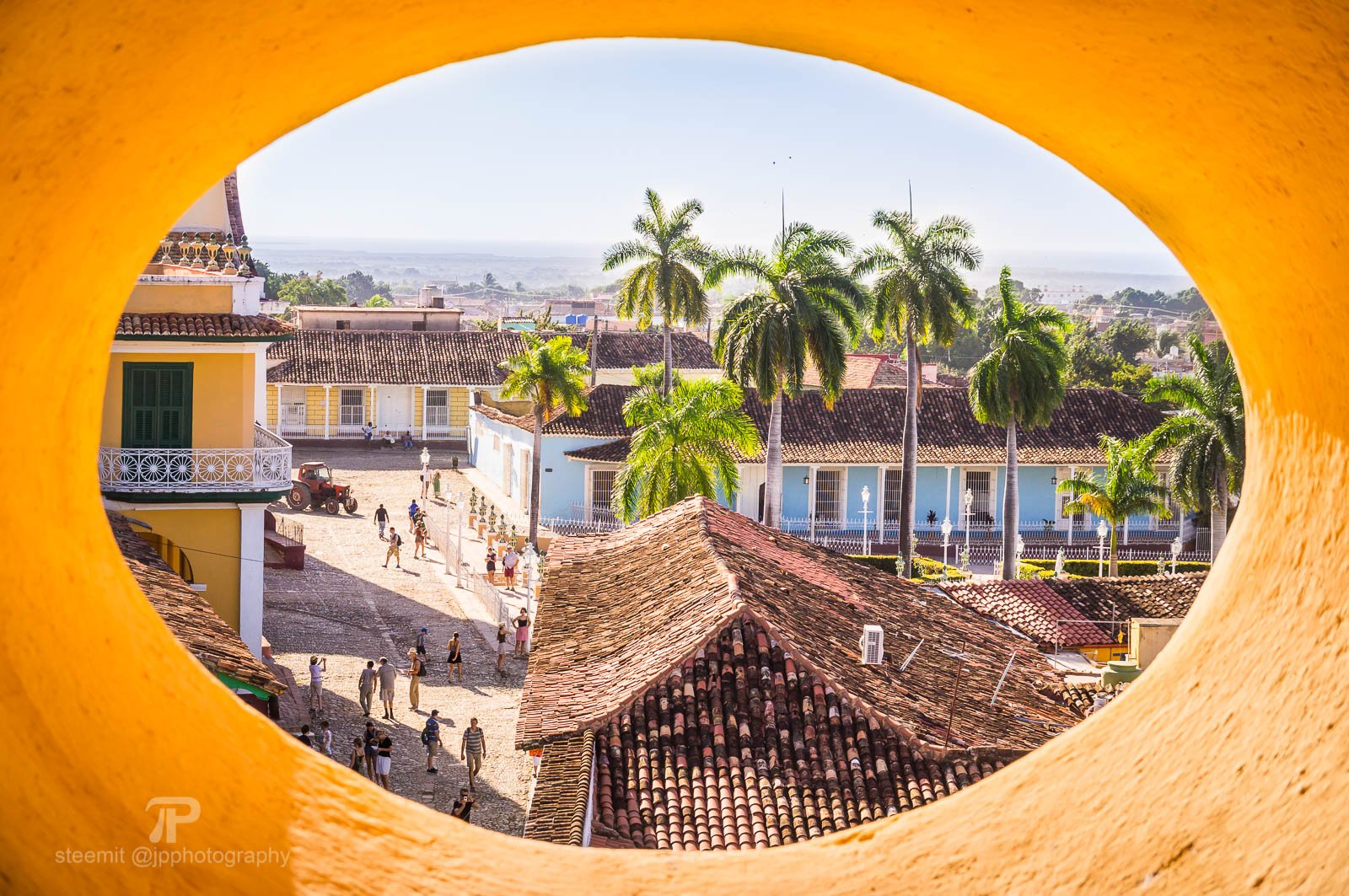
Two years ago I was travelling in Cuba for four weeks. I have tried to experience Cuba as it really is using local transport, eating local food and talking to many amazing people. Today I want to share some of my favourite photos from Trinidad and some insights into the Cuban society and economy. I will show you the romanticized decay that makes Cuba famous as well as the life behind the colourful facades.
If you want to know more about Cuba, head over to Part 1 of my series on Cuba, my photo documentary about Havana.
View on Plaza Mayor
The colonial town of Trinidad looks like it has been cut out from a movie that is set in the Caribbean some centuries ago. Trinidad has been one of the first European settlements in the New World.
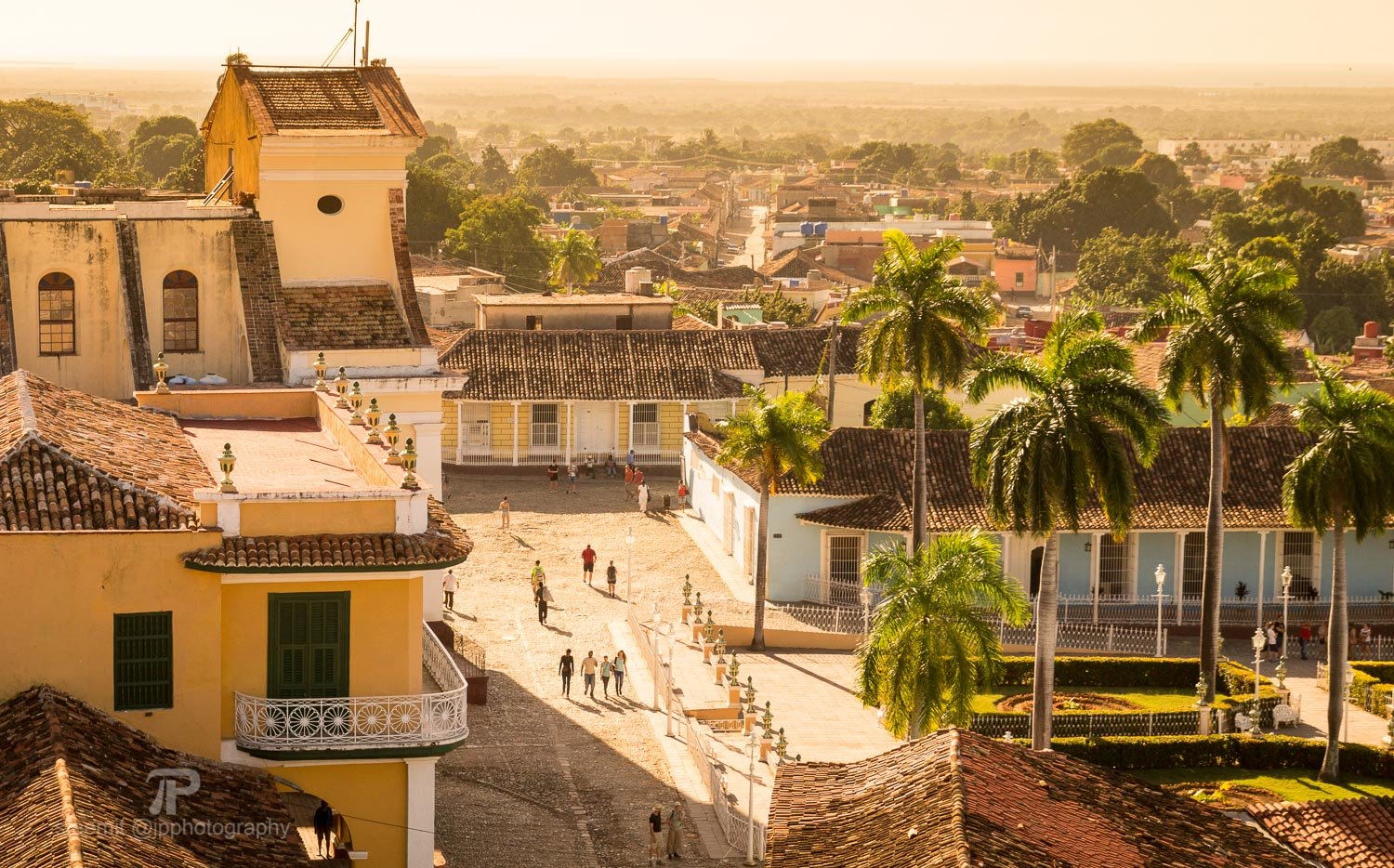
50mm, f9, 1/320; Click on image to enlarge.
Tourist Destination Trinidad
Today, the beautiful colonial town is visited by thousands of tourist every day who flock in from the resorts around Varadero and the capital Havana.
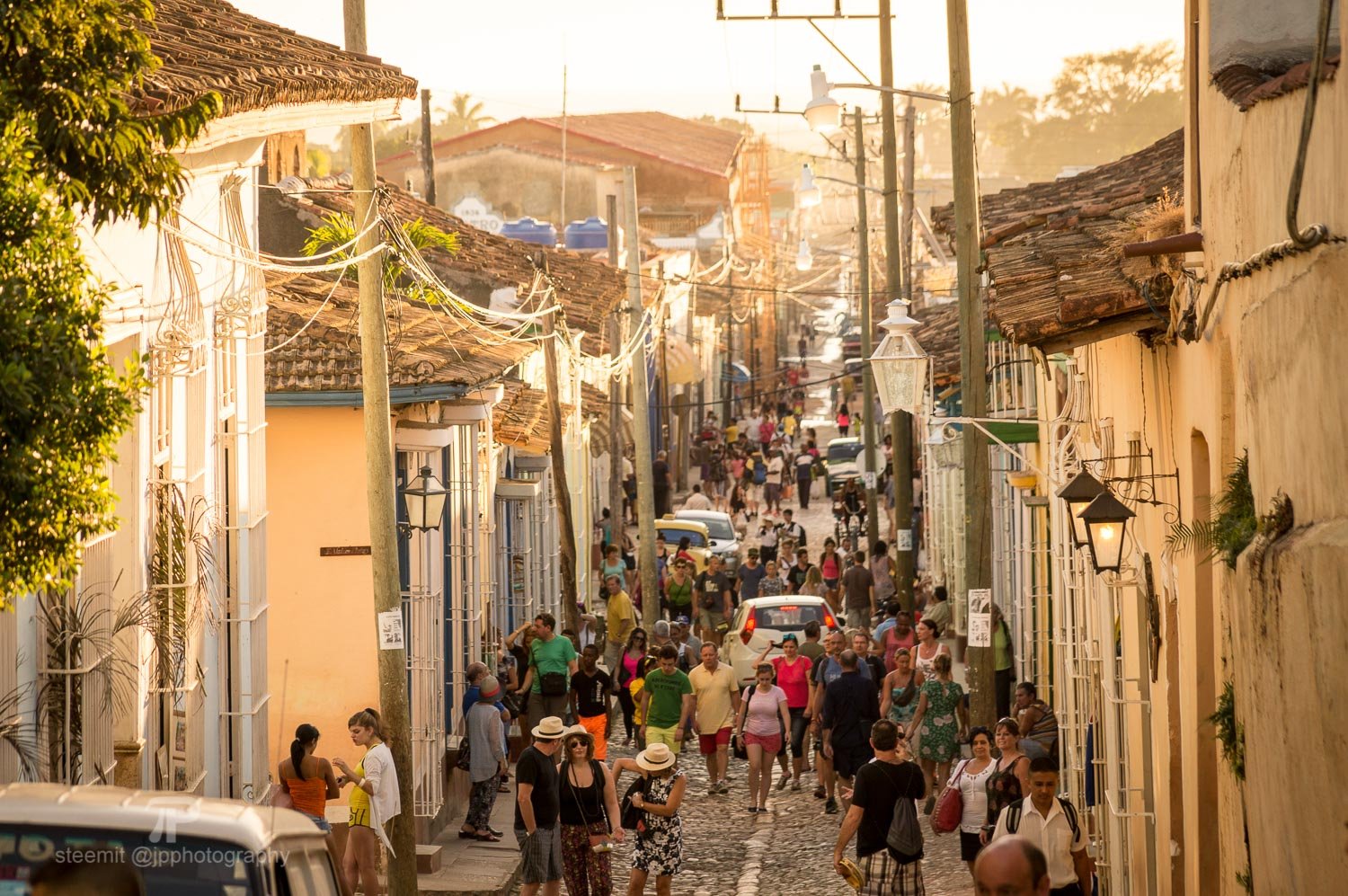
135mm, f5.6, 1/160; Click on image to enlarge.
Colourful Facades
The centre of town is really beautiful, since mainly thanks to the poor economic situation of the country no buildings have been torn down or been replaced by modern buildings. Recently, the colonial buildings in Trinidad have been renovated and look really beautiful.
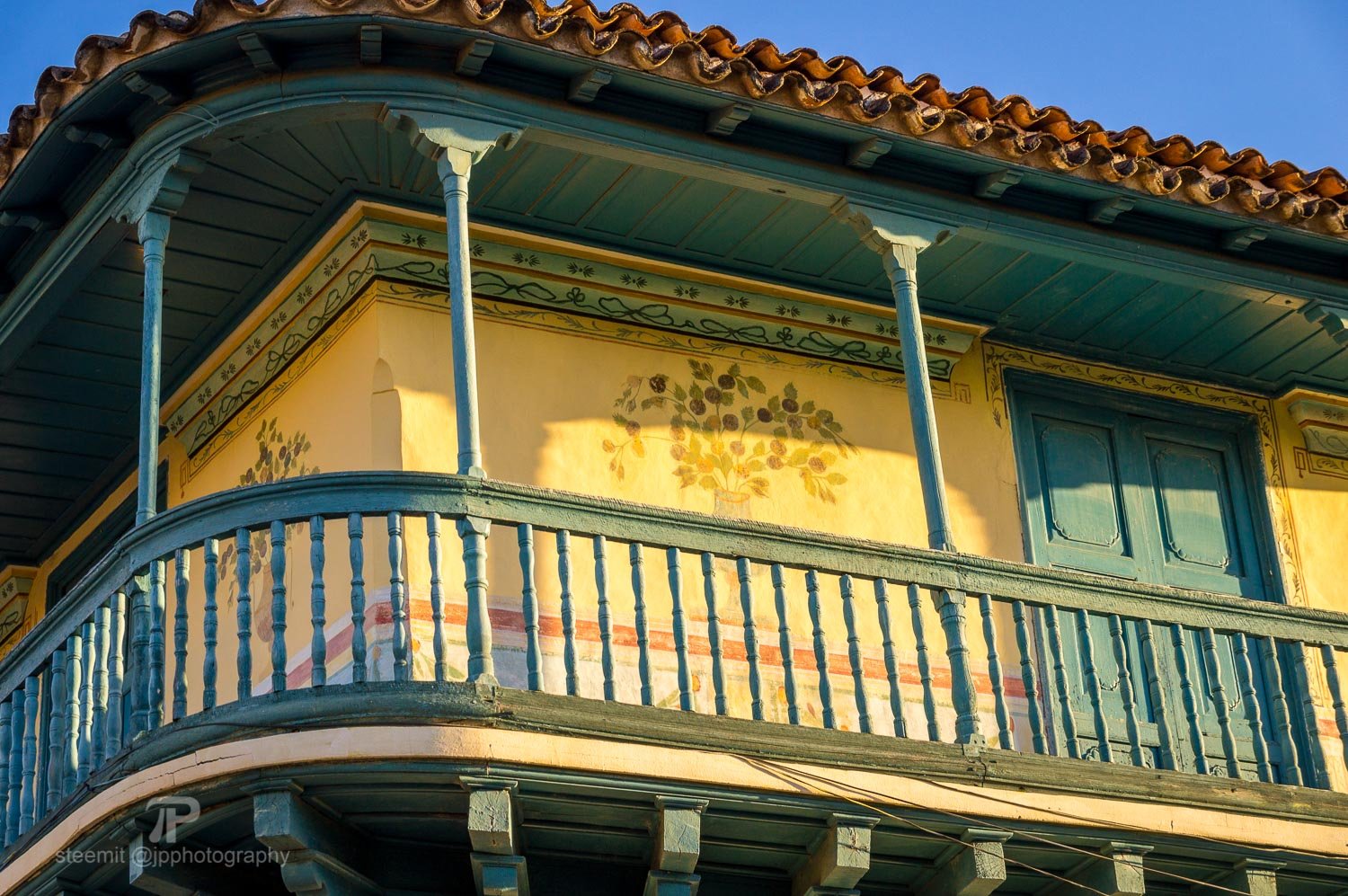
50mm, f8, 1/200; Click on image to enlarge.
Colonial Architecture
Various museums are set around the centre of town, all of them will try to convince you how awesome the Cuban Revolution has been.
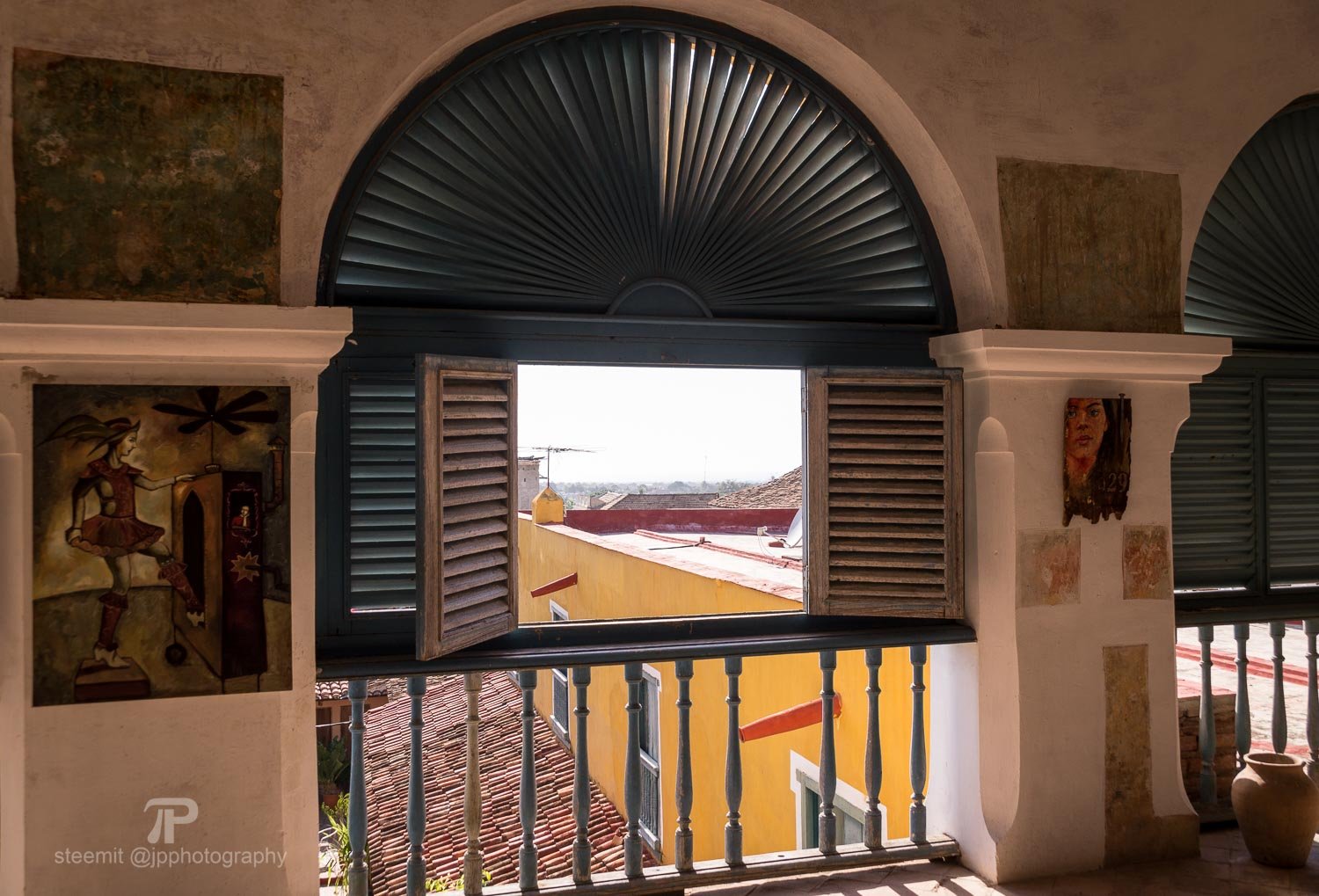
22mm, f7.1, 1/200; Click on image to enlarge.
Classic Cars roaming the Streets
A reason for many tourists to visit Cuba are the classic cars that can be found everywhere.
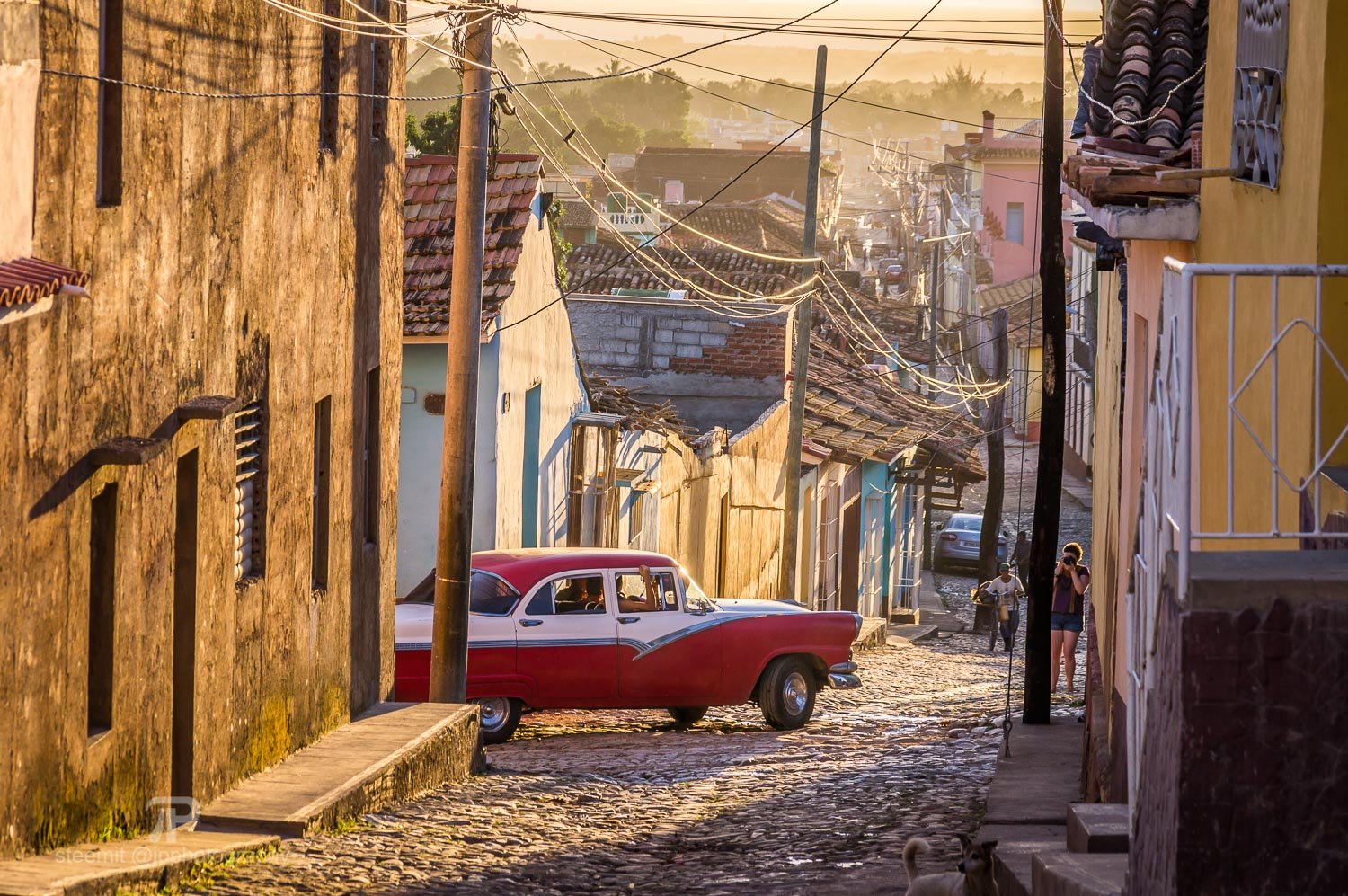
100mm, f6.3, 1/200; Click on image to enlarge.
Cars and the US-Embargo
While it is not true that all cars in Cuba are classic cars, many of them are, since the trade embargo placed upon Cuba by the US government since 1962 makes it quite hard to import modern cars to the isolated country.
Since most of the cars in Cuba are still owned by the government that tries everything to bring foreign currency into the country, many classic cars are now operated as taxis for tourists.
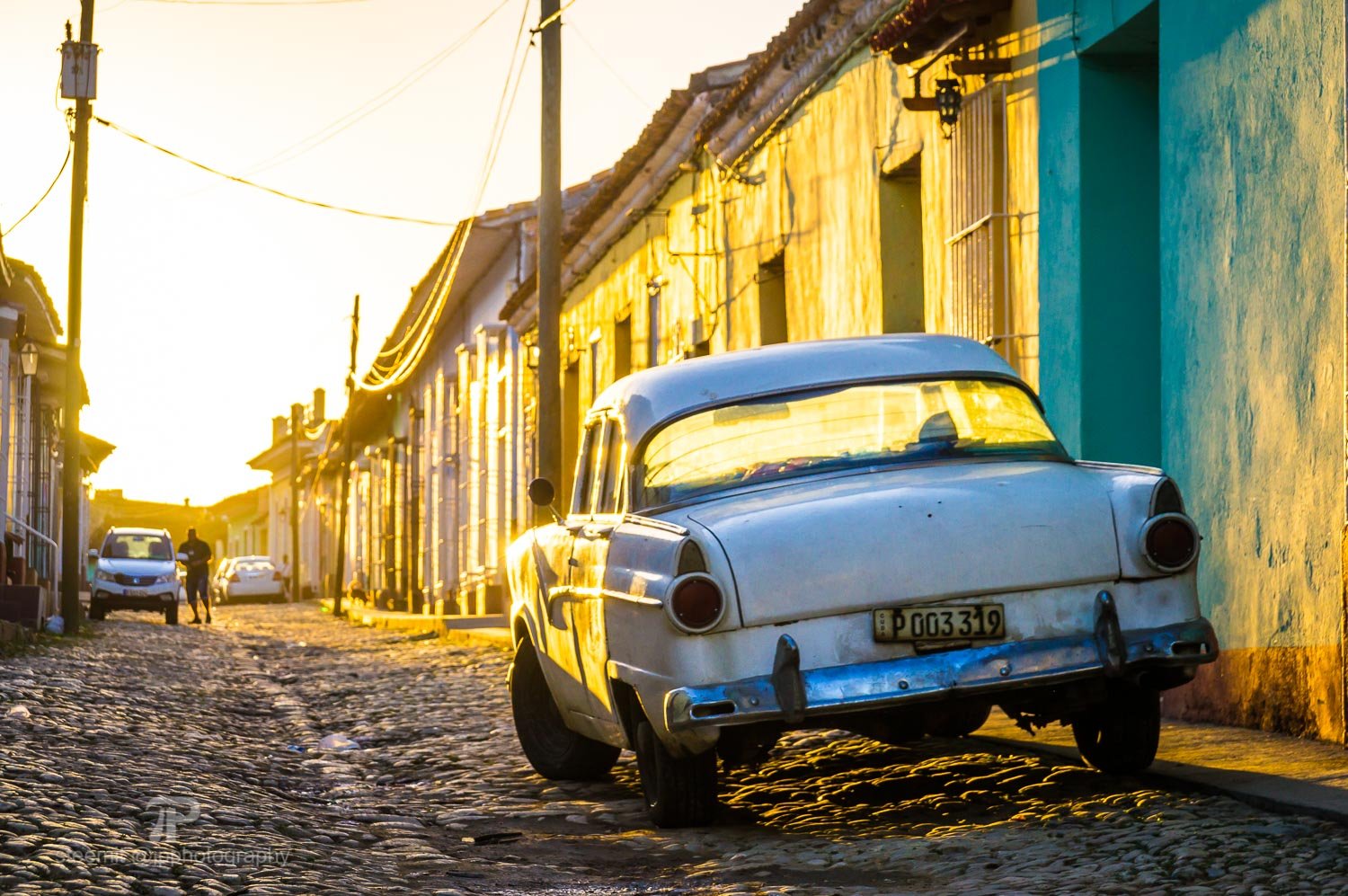
70mm, f8, 1/250; Click on image to enlarge.
Expensive Taxis: Only for Tourists
Most Cubans would never be able to afford the tourist taxis. If they can afford them, they use taxis collectivos, shared rides, which cost a fraction of the price of a ride in a tourist taxi. So if you are travelling on a budget and would like to get a ride in a classic car, look out for a taxi collectivo and pay with Pesos Cubanos (more on this currency later).
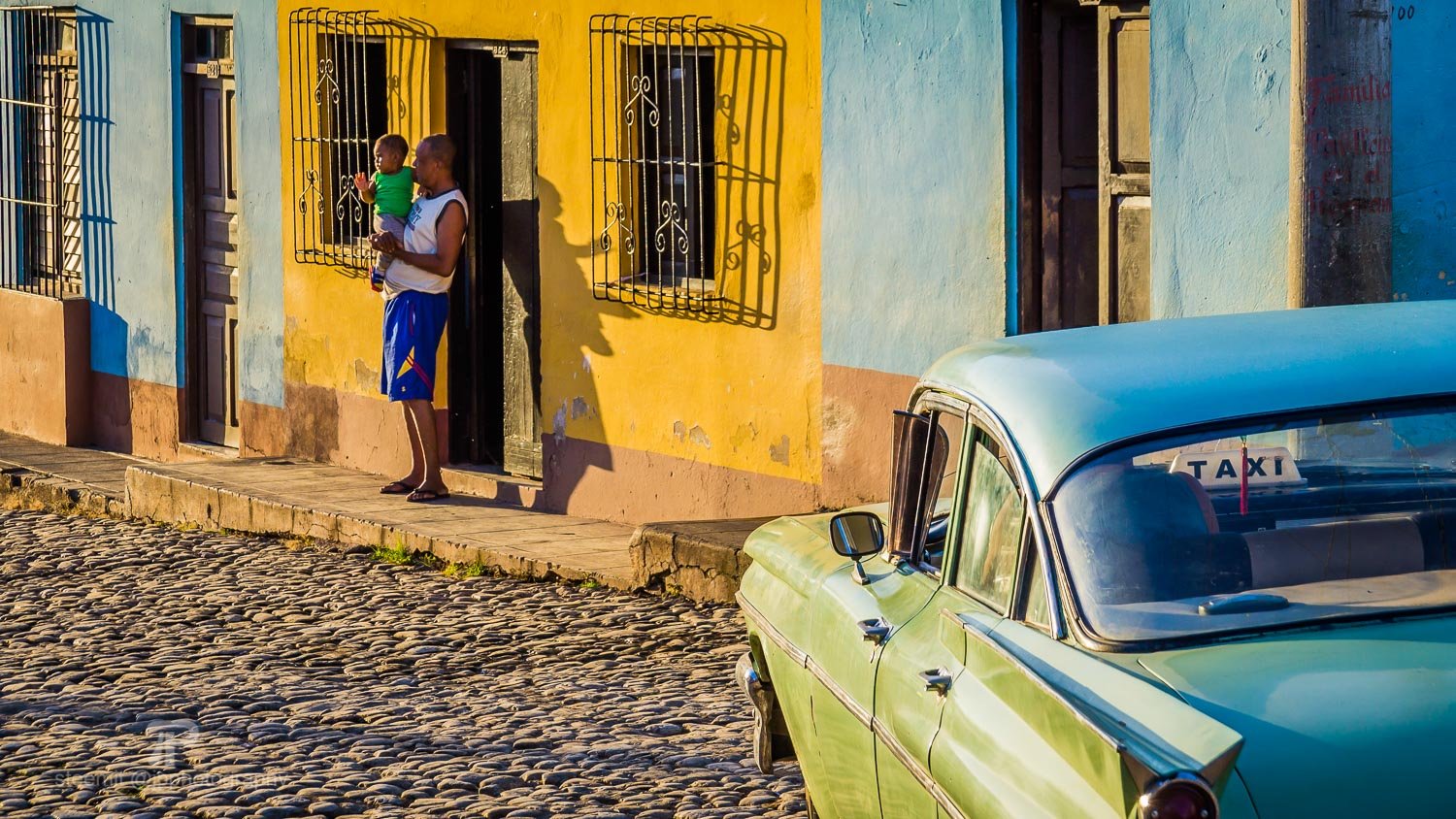
75mm, f8.0, 1/250; Click on image to enlarge.
Fuel efficient: The moto taxi
Another option popular with Cubans and a way to avoid the relative to the income very high fuel prices are the moto taxis. The problem with them is, that these scooters still need some fuel. Cuba used to buy oil from its socialist brother country Venezuela, but recently Venezuela's economy has been struggling a lot, so they can't afford to support Cuba any more.
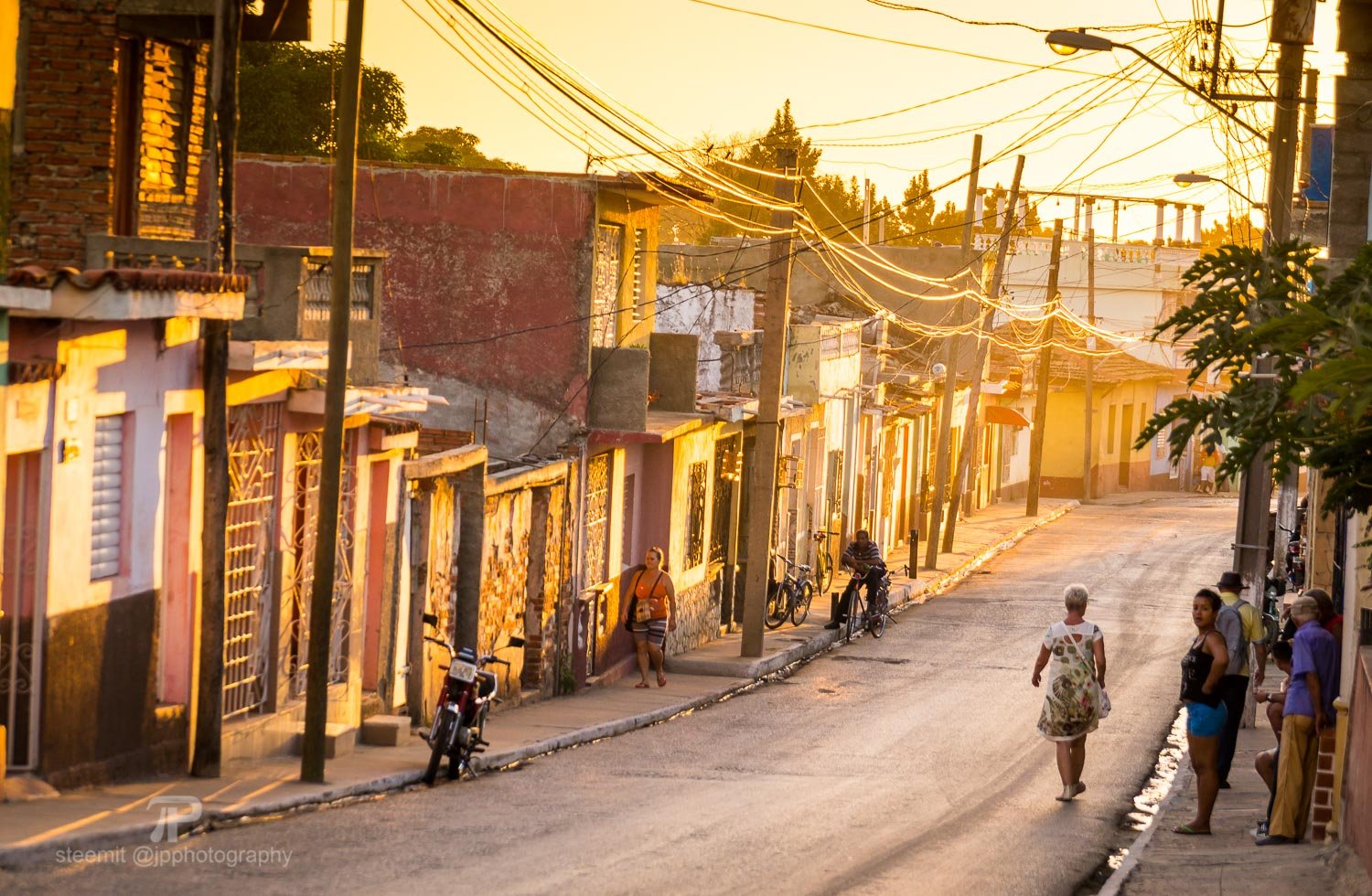
80mm, f5.6, 1/125; Click on image to enlarge.
The best Option? Bicycles!
This is where bicycles come in handy. They are widely popular all over Cuba but are quite an investment to make since second hand bicycles are far more expensive than in capitalist countries where we can easily afford new bicycles.
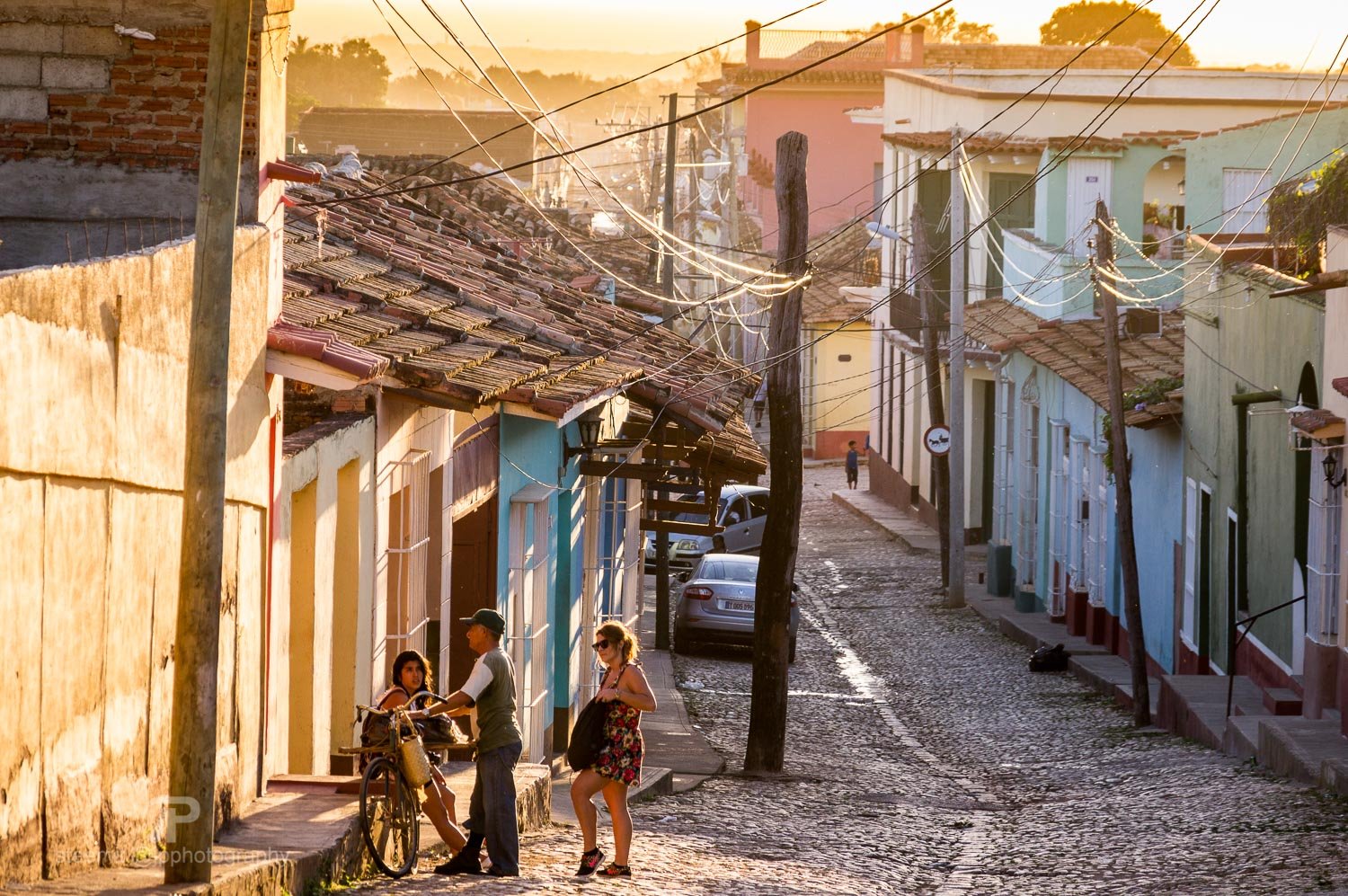
105mm, f5.6, 1/160; Click on image to enlarge.
Horses are still popular in Cuba.
Bicycles are great for getting one person from one place to another, but in some cases there is a better way.
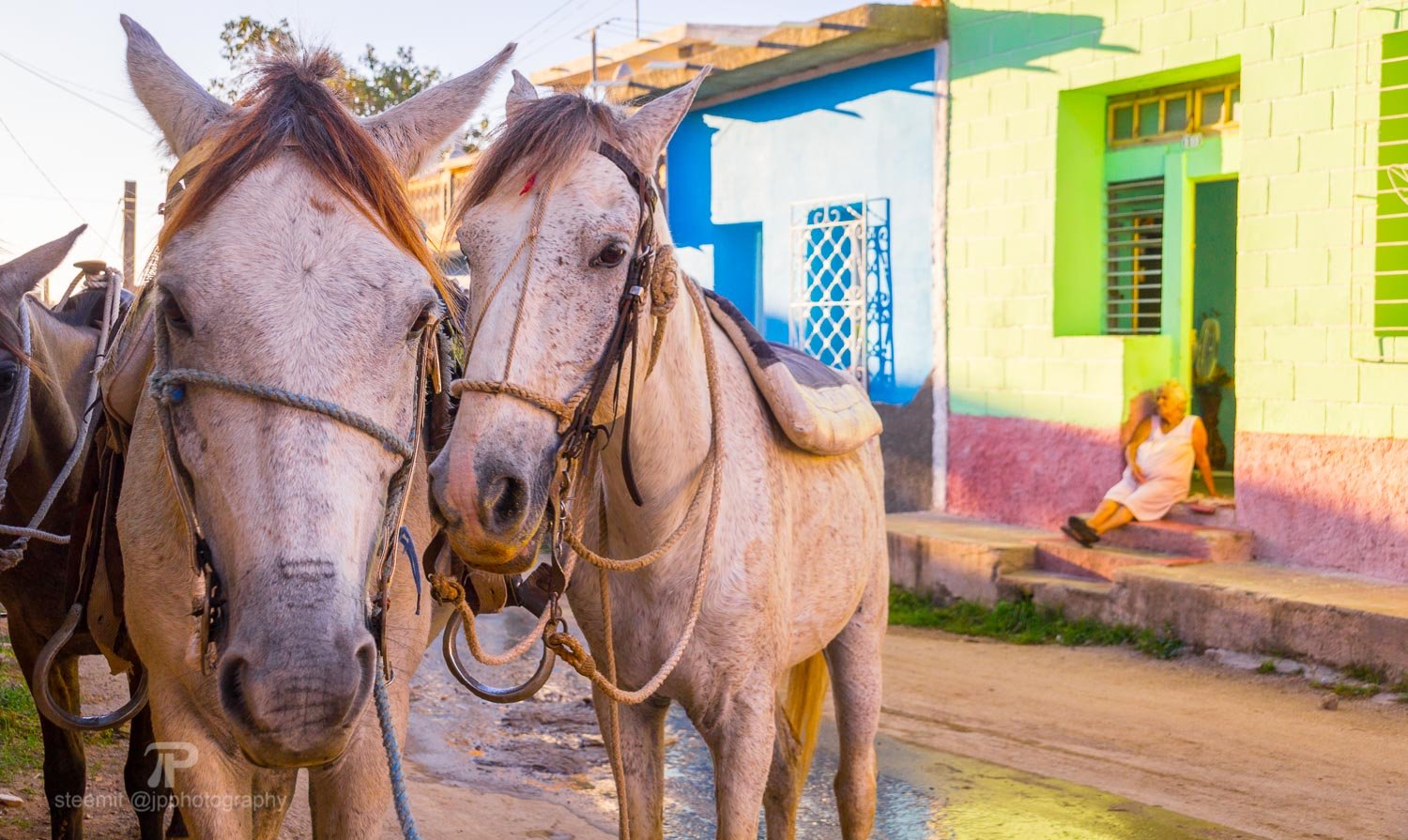
26mm, f6.3, 1/200; Click on image to enlarge.
One Horse Power
Horses are capable of transporting people as well as cargo. The best about horses is, that they run on food instead of gas, and while Cuba has no oil reserves, they can feed their horses with the produce of their own agriculture.
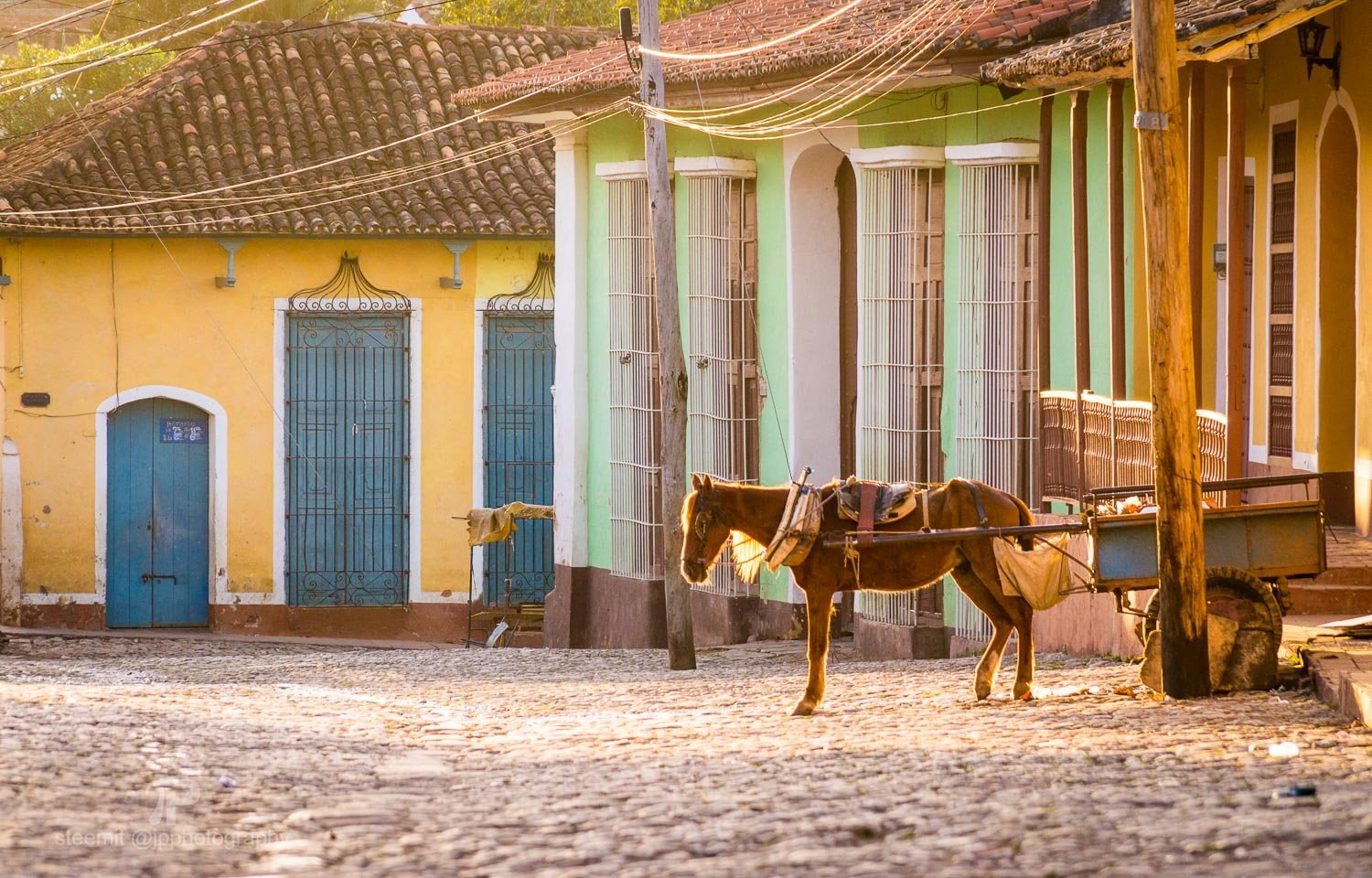
135mm, f5.6, 1/250; Click on image to enlarge.
Forget Buses, in Trinidad they have Carriages!
Even in the 21st century, in Cuba horse drawn carriages are widely popular as a replacement for the unreliable government buses.
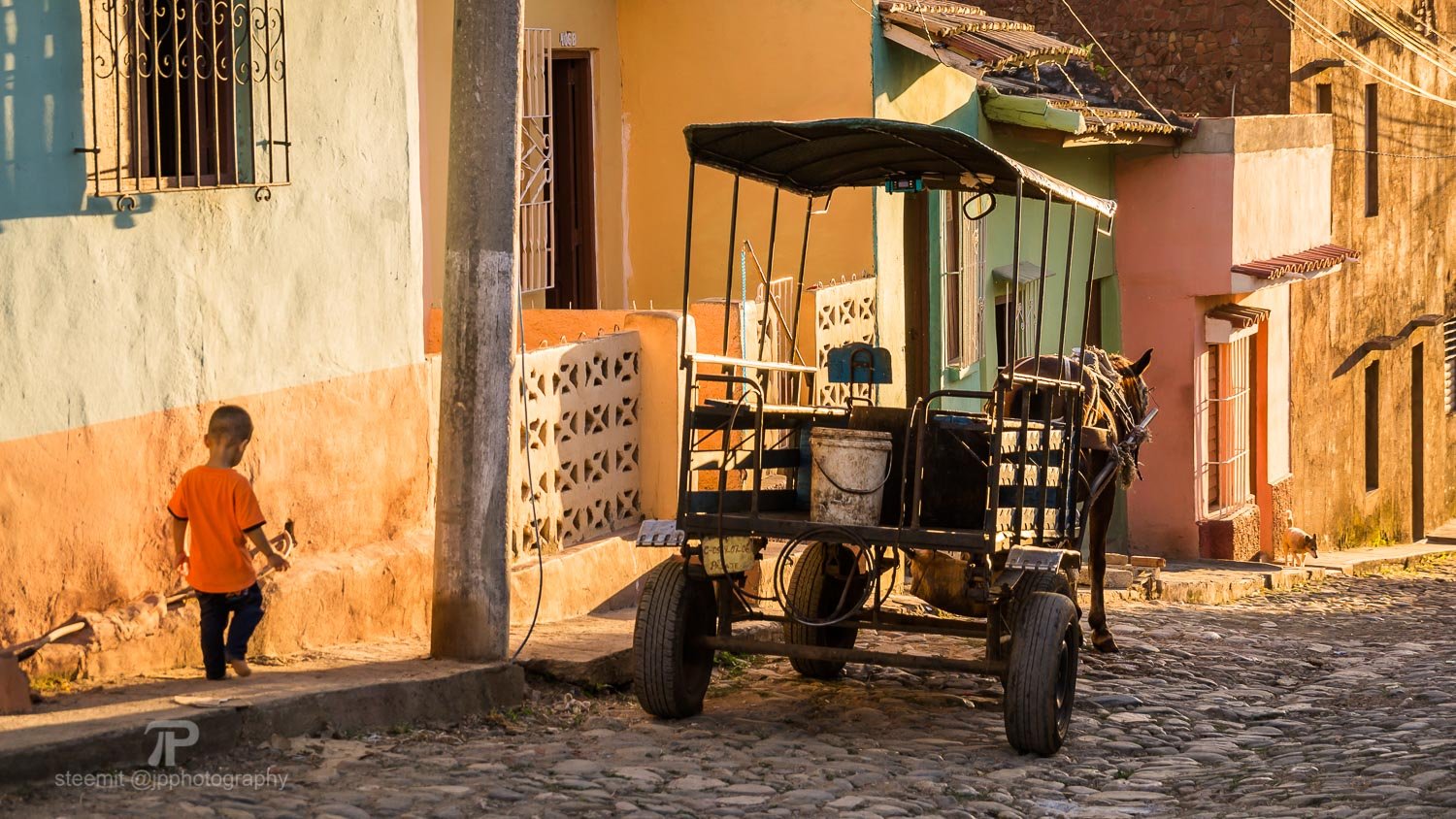
50mm, f6.3, 1/125; Click on image to enlarge.
Advertisement in Socialism
As bad as socialism is for the people in Cuba, you have to let them one thing: The advertisements on the back of buses are way prettier than the one in the capitalist countries!
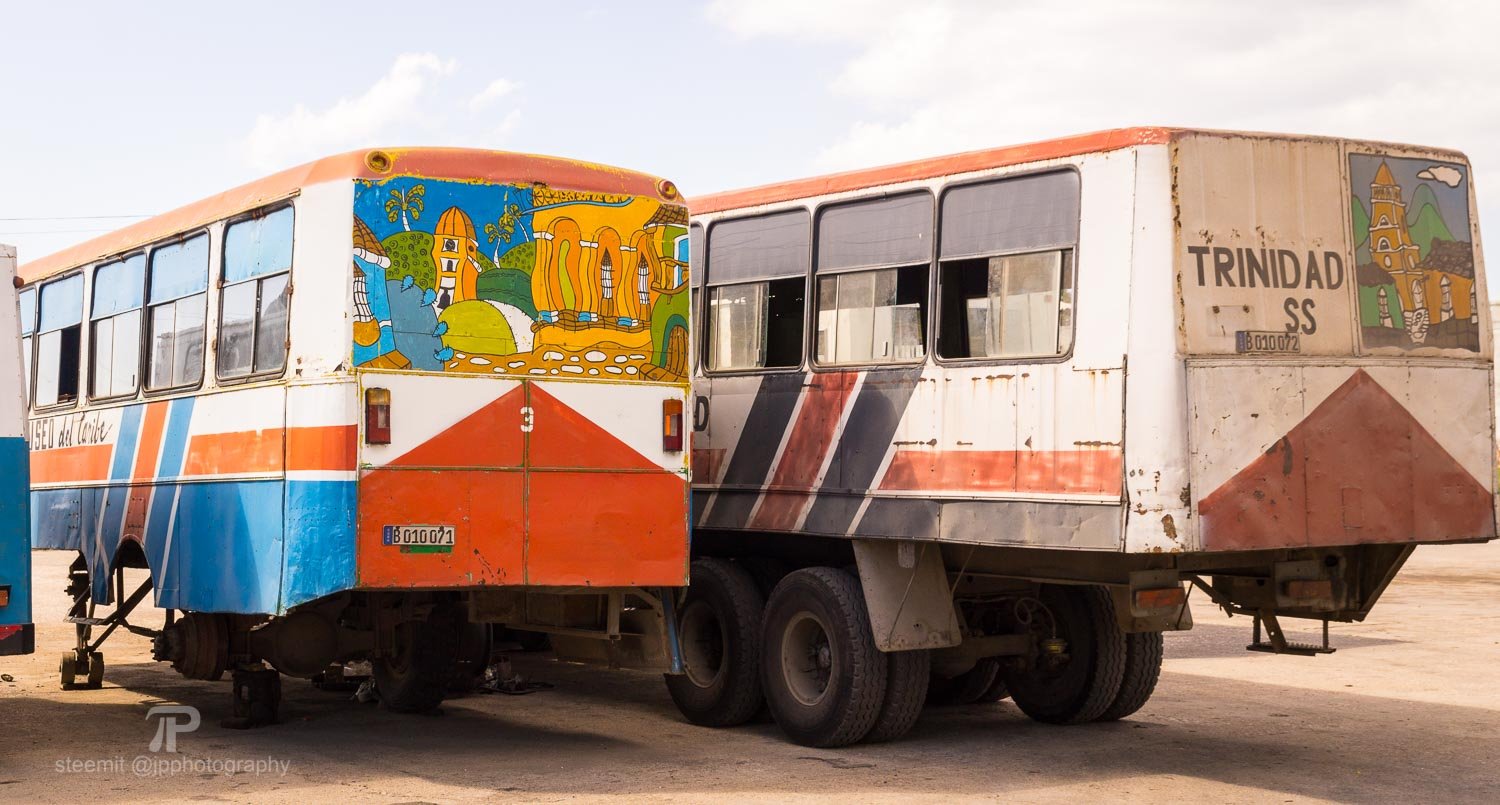
35mm, f8, 1/250; Click on image to enlarge.
Cuban Buses
There are different kinds of buses in Cuba. Modern long distant buses for tourists are run under the brand Viazul, while the older buses run by Astro are cheaper and only for Cubans (believe me, I tried to get on many times, no chance).
When I visited Cuba at Christmas time 2015, Viazul buses were booked out days ahead, so I decided to get around in local buses. These buses are called camiones in Cuba, which means "truck" in Spanish. And well, this is what they are, trucks with some benches installed in the back and cramped with as many people as possible. The buses are the chosen way of transport for many Cubans who cannot afford the Astro buses. A trip in a camion is a unique experience, but I would not recommend crossing Cuba in these vehicles (I did though..). Also, there is a railway line crossing Cuba from West to East, but Trinidad is not connected to the main railway line.
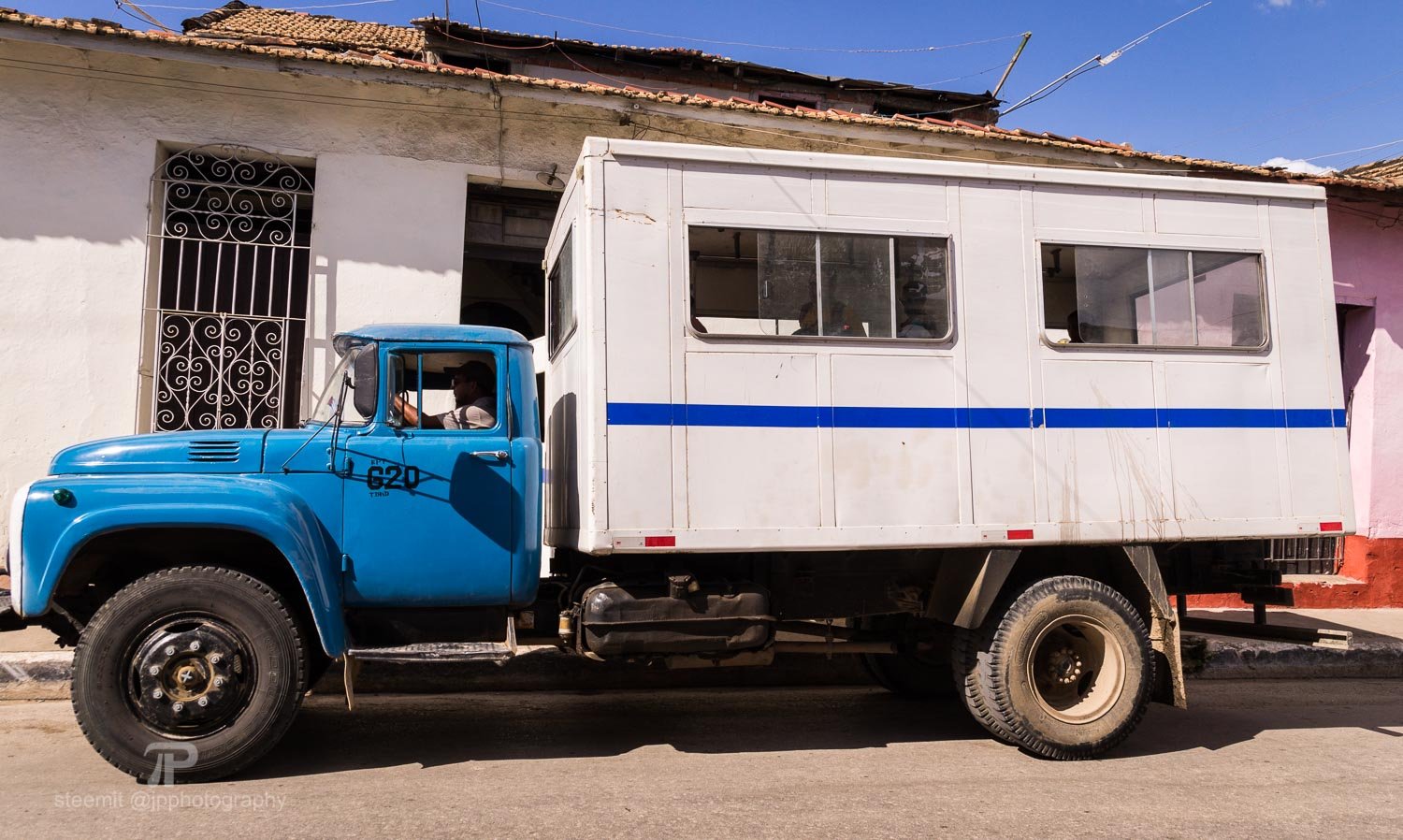
18mm, f8, 1/640; Click on image to enlarge.
Tourists enjoying a Tourist Restaurant
Let's get back to the centre of town, where tourist can enjoy the warm afternoon light in a restaurant. They will pay a few dollars for a meal here, which is very reasonable for Western standards. But you may remember from my last post that Cubans salaries can be as low as 15 USD a month, so how could they ever be able to afford to eat at a restaurant?
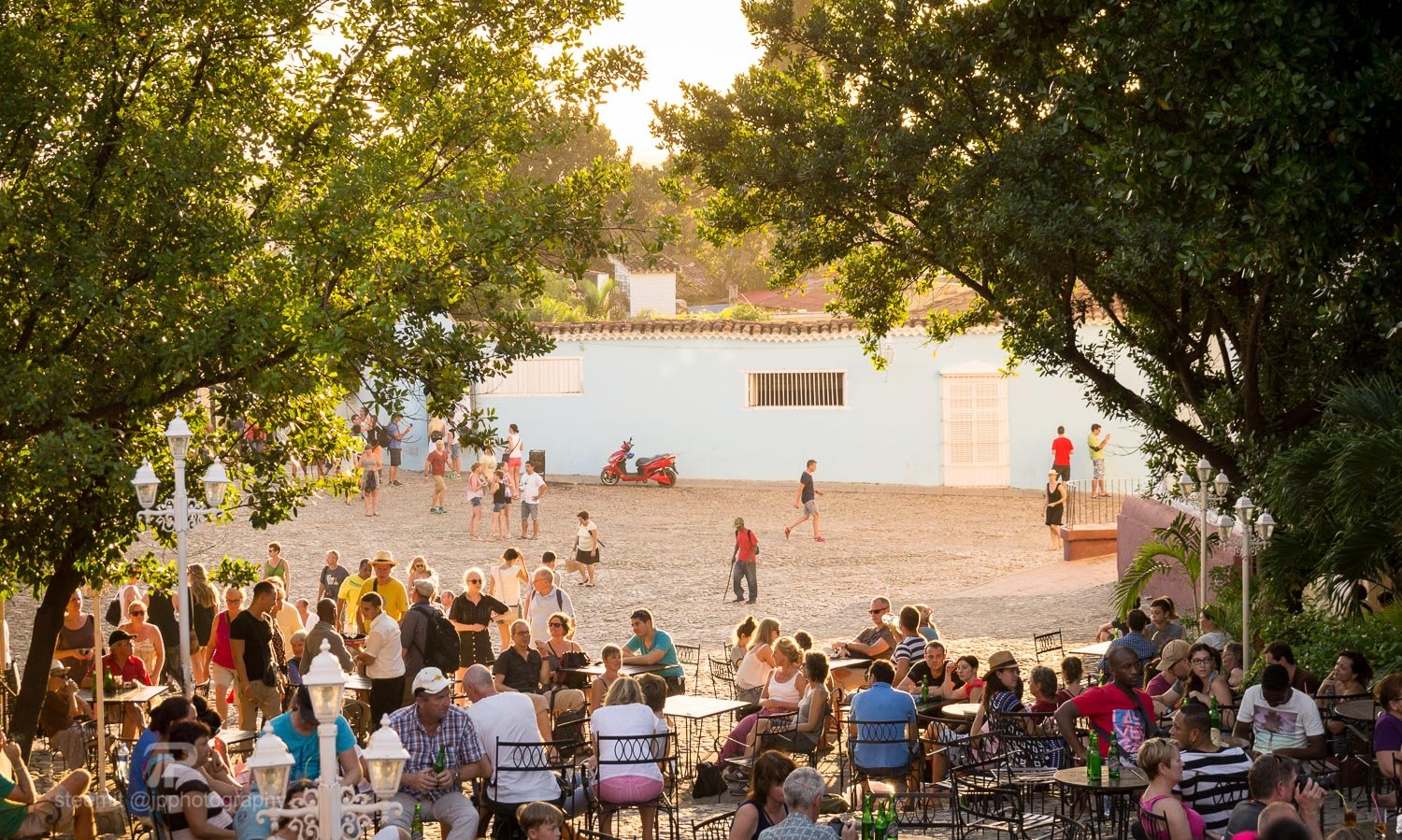
50mm, f6.3, 1/125; Click on image to enlarge.
One country, two currencies — Just like Steemit!
Well, let me introduce you to the Cuban currency system. While we as Steem and crypto users are used to handling multiple currencies, it comes as a shock to many tourists that there are actually two currencies in Cuba.
After the collapse of the Soviet Union, Cuba went through a severe economic crisis. Since the socialist Caribbean country has almost no industry, the value of the Cuban Peso dropped a lot and the Cuban government struggled to pay for any imports since nobody was willing to accept the currency of a failing economy. Currently, one Cuban Peso is worth only 0.04 USD.
Quickly, the US-Dollar became the real currency in Cuba, since its value was stable. At one point the Cuban government had to accept this, but they quickly realized that having the currency of their arch-enemy might not be the best thing to do. So they came up with a second currency pegged to the US-Dollar, the Peso Convertible.
The Peso Cubano is also often referred to Peso Nacional, while the Peso Convertible is called CUC. To make this more confusing, both can be referred to as Peso.
For Cubans, all goods except luxury and imported items are paid in Pesos Cubanos, while most tourists will only pay with CUC during their visit. The great news is, that you can exchange your CUC to Pesos Cubanos completely legal in one of the government-run change houses (casa de cambio). After commission, 1 CUC gets you 24 Pesos Cubanos and in fact you can pay anything but accommodation in Pesos Cubanos and travel incredibly cheap!
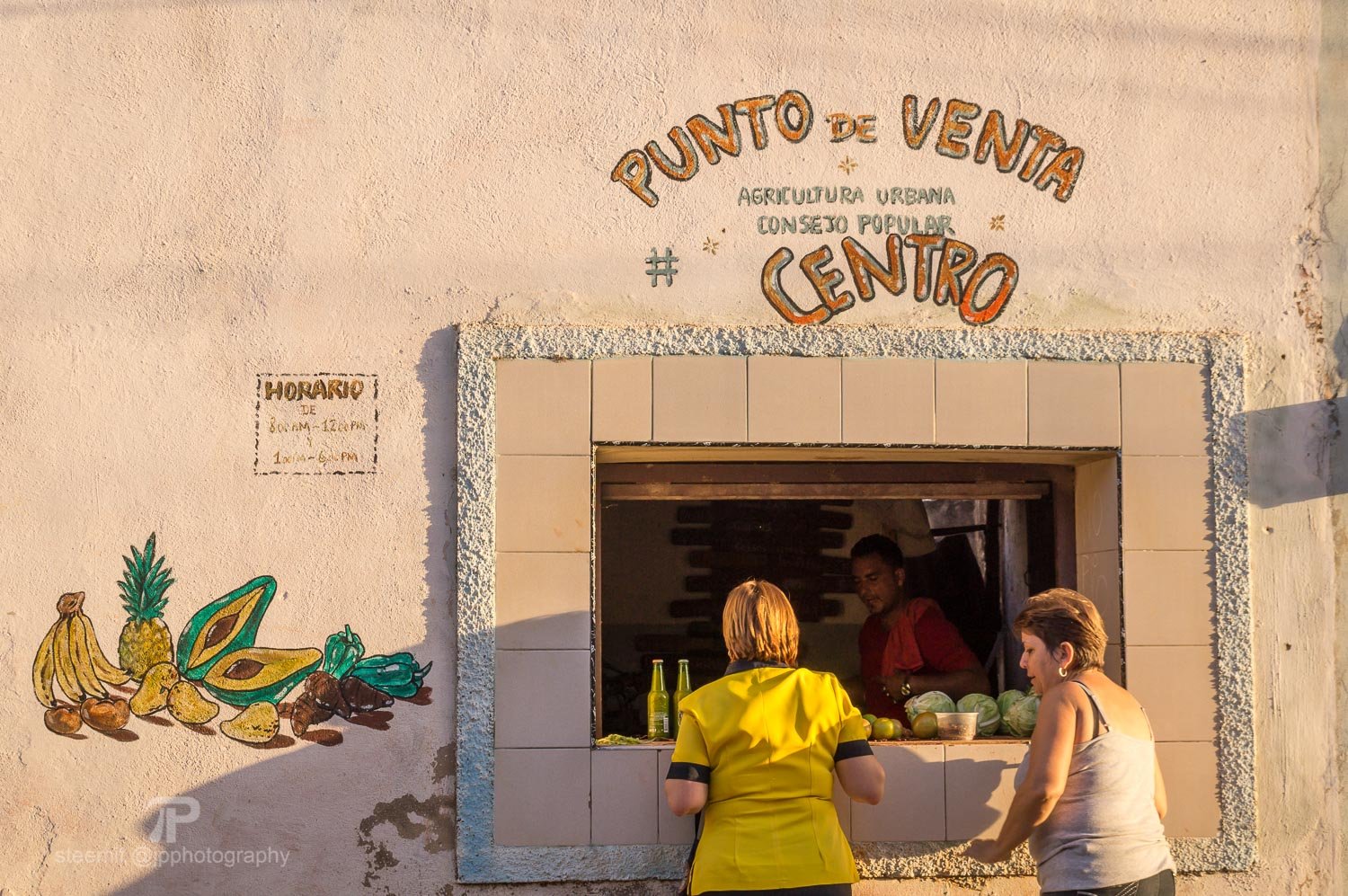
35mm, f8, 1/200; Click on image to enlarge.
The cheapest Food in the World?
Here you can see some prices for food from a small street side cafeteria. You can get a delicious cheese pizza for 5 Pesos (0,20 USD!) and a bucket of ice cream for the same price for dessert. Even if you feel like a millionaire, I encourage you not to start giving away money, since generous tourists are becoming an increasing problem for the Cuban economy: If begging tourists for a Dollar earns more money than working for the government, the Cuban economy will do even worse which will be bad for everyone. The socialist government may not enable most people to get rich, but they make sure to provide shelter and food for everyone, so real poverty in Cuba is actually lower than I have seen in any other Latin American country and so theoretically nobody would need to beg for money.
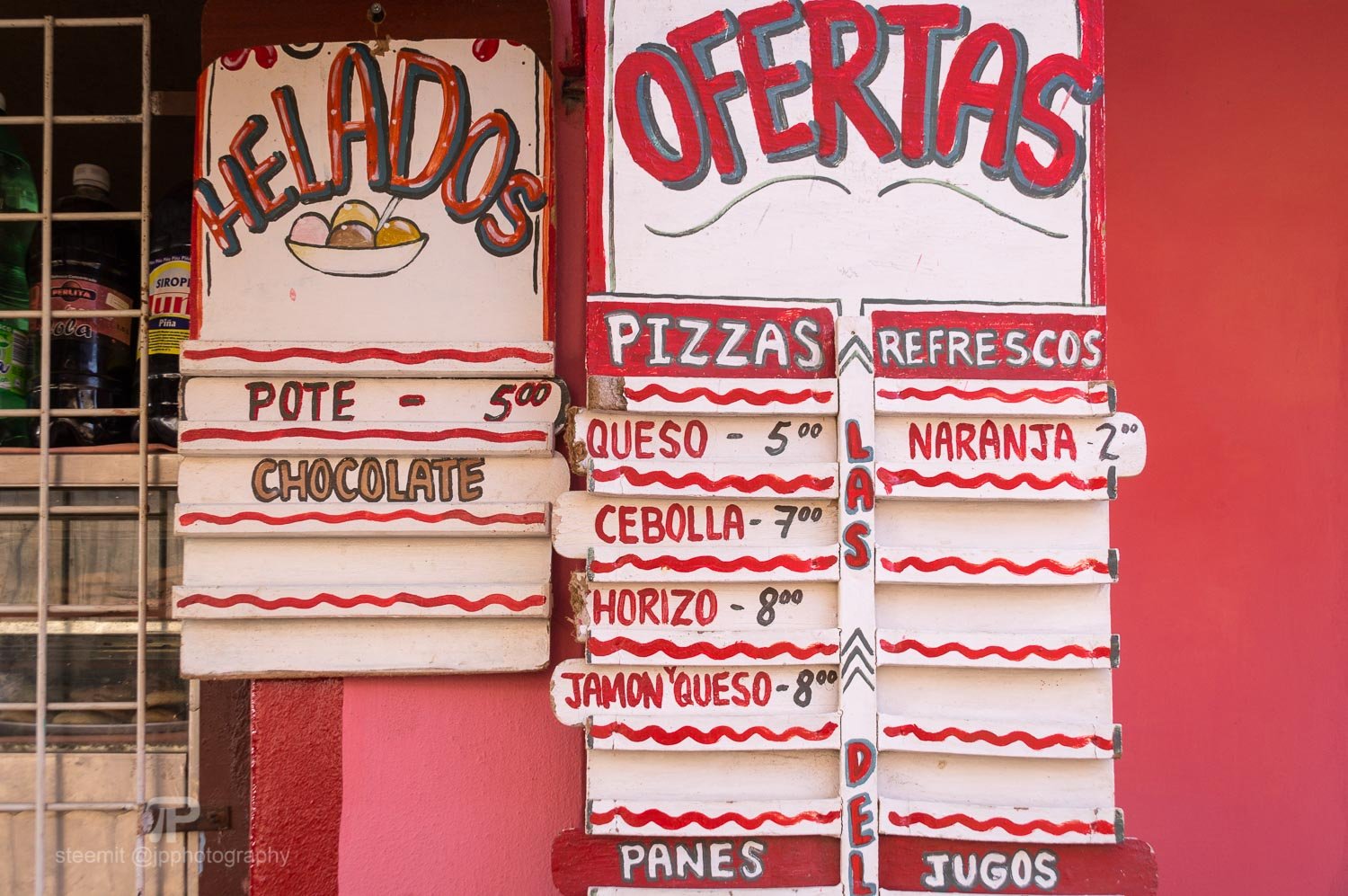
22mm, f5.6, 1/125; Click on image to enlarge.
Cafeterias: Eating like a Cuban
There are also many government run restaurants for the locals around where you pay a few Pesos Cubanos for a decent meal, but the small cafeterias are actually quite a new sight in Cuba: They are actually not owned by the government, since a few years back the government decided to allow Cubans to start small businesses. Since then, there have been many family run pizza shops like this one opening up all around the country.
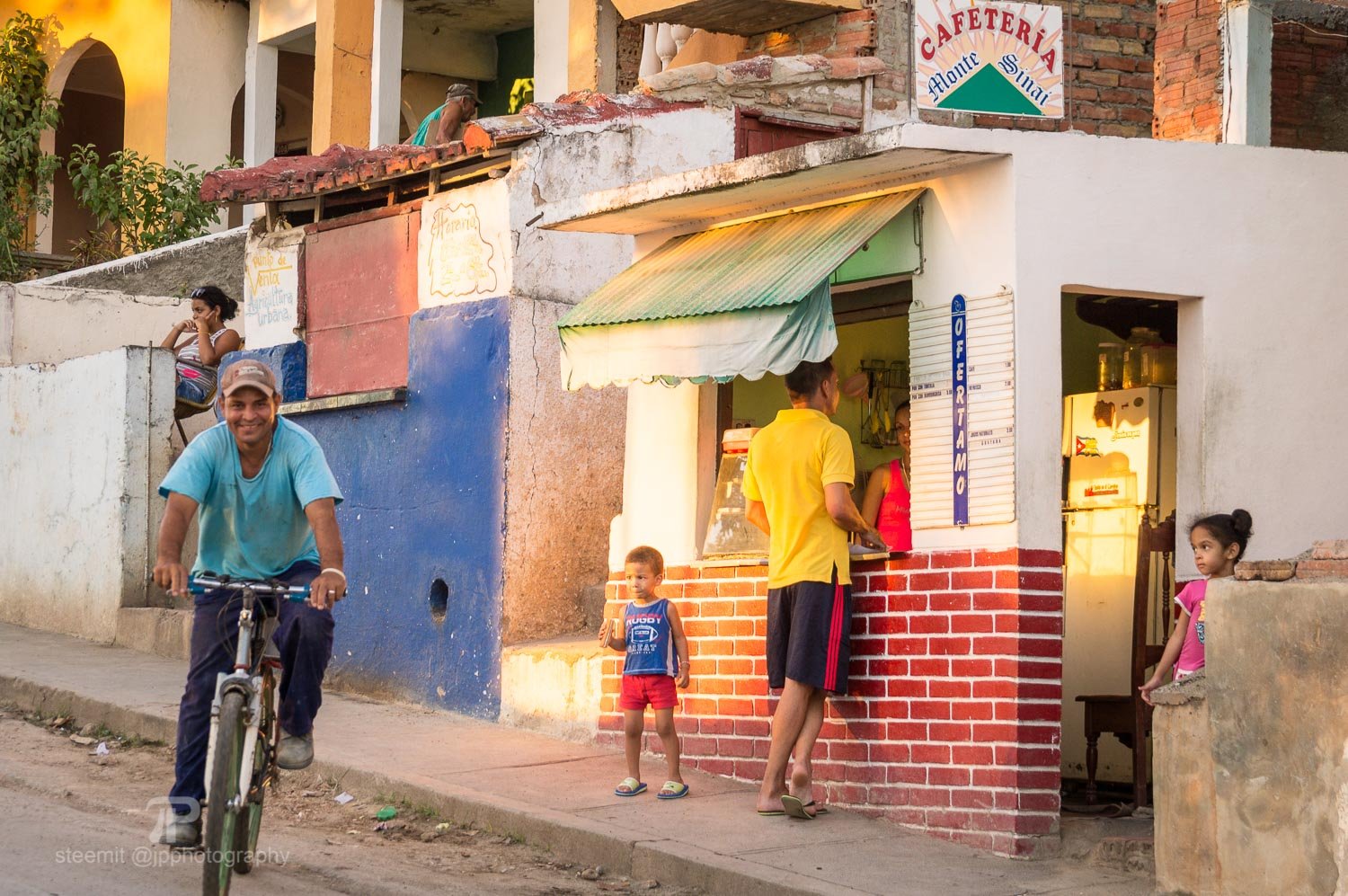
55mm, f5, 1/100; Click on image to enlarge.
The Cuban Spirit
Although having very little money compared to people from the Western world, people in Cuba seem a lot happier, they smile more and spend time with their friends and neighbors.
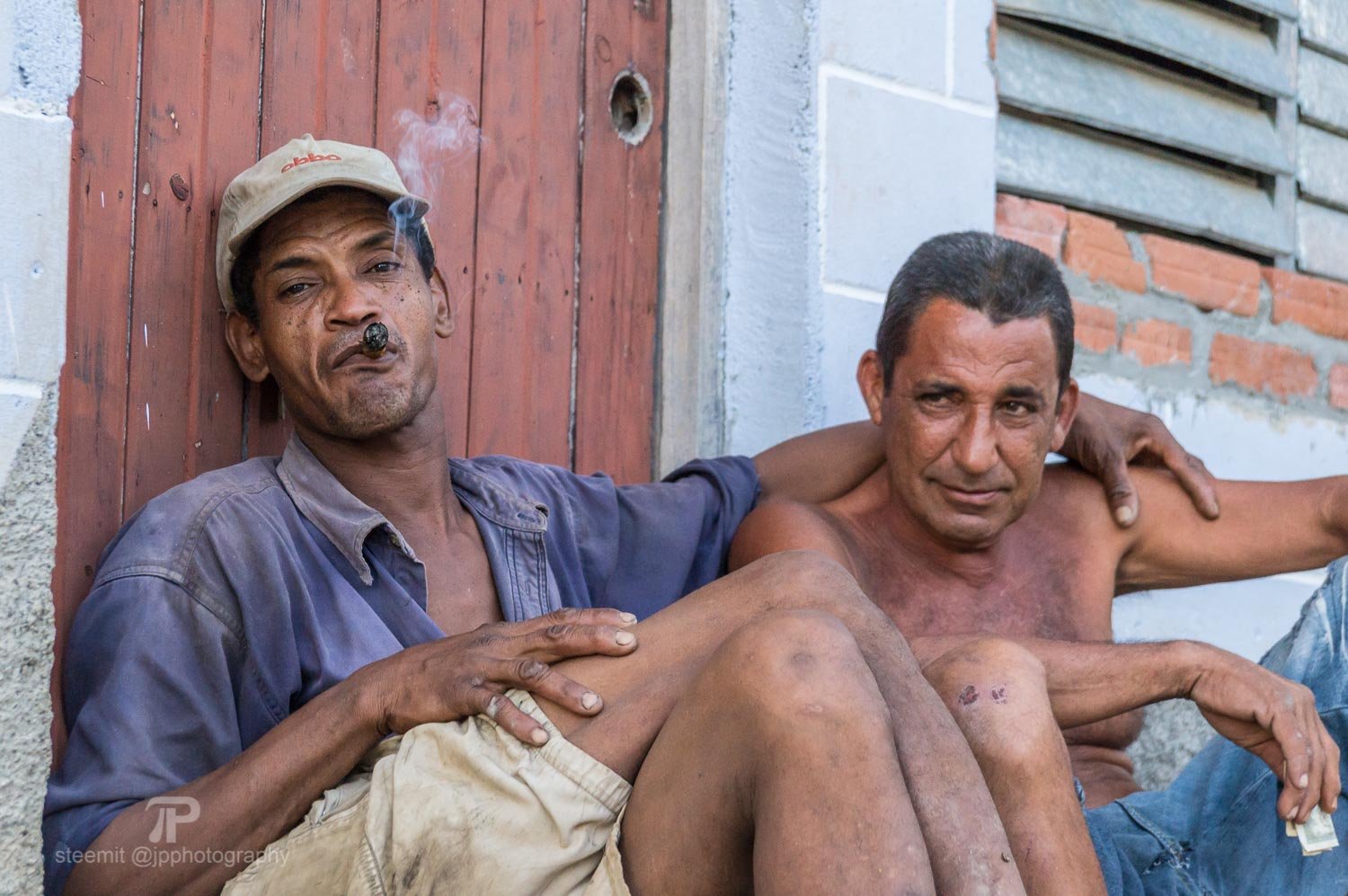
70mm, f5.6, 1/125; Click on image to enlarge.
Streets filled with Life
I don't know if it is the Latin American spirit or the fact, that only some people own a TV, but the streets in Trinidad are filled with life.
Life in Cuba seems a lot more social than in many Western countries where everyone sits in their own apartment in front of their own TV. It is funny though that people in socialist Cuba actually have a very capitalist mindset and dream of buying their own smartphone or TV, while some people in the Western industrial countries are slowly realizing that there is more to life than money. I think cryptocurrencies demonstrate every day how relative the value of money is, so working a well paid job you hate is not be worth sacrificing social life.
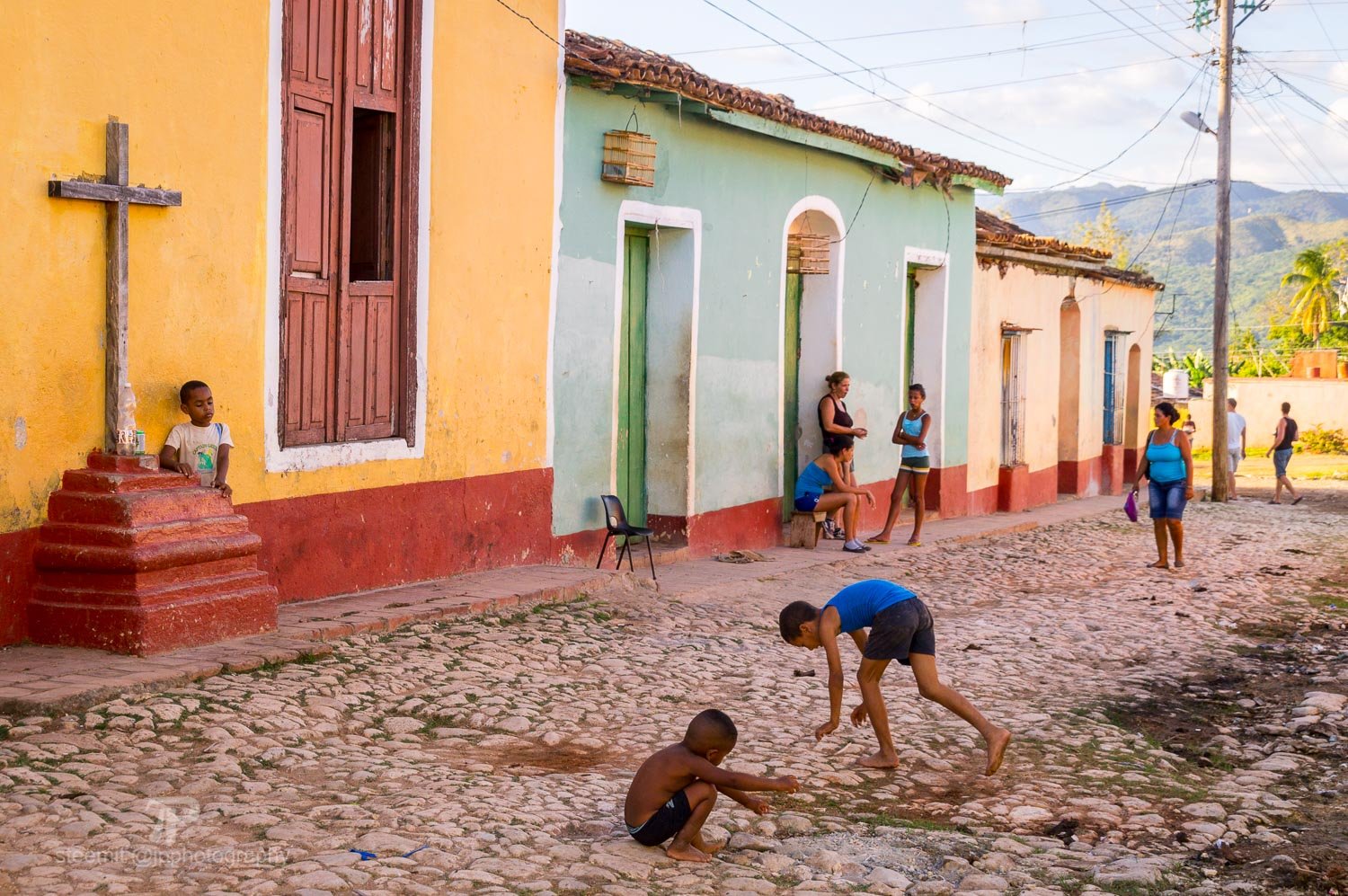
30mm, f7.1, 1/160; Click on image to enlarge.
A "real" Playground
Another reason while there are so many kids playing on the streets might be the playgrounds in the suburbs. Seriously, who would like to play at a place like this?
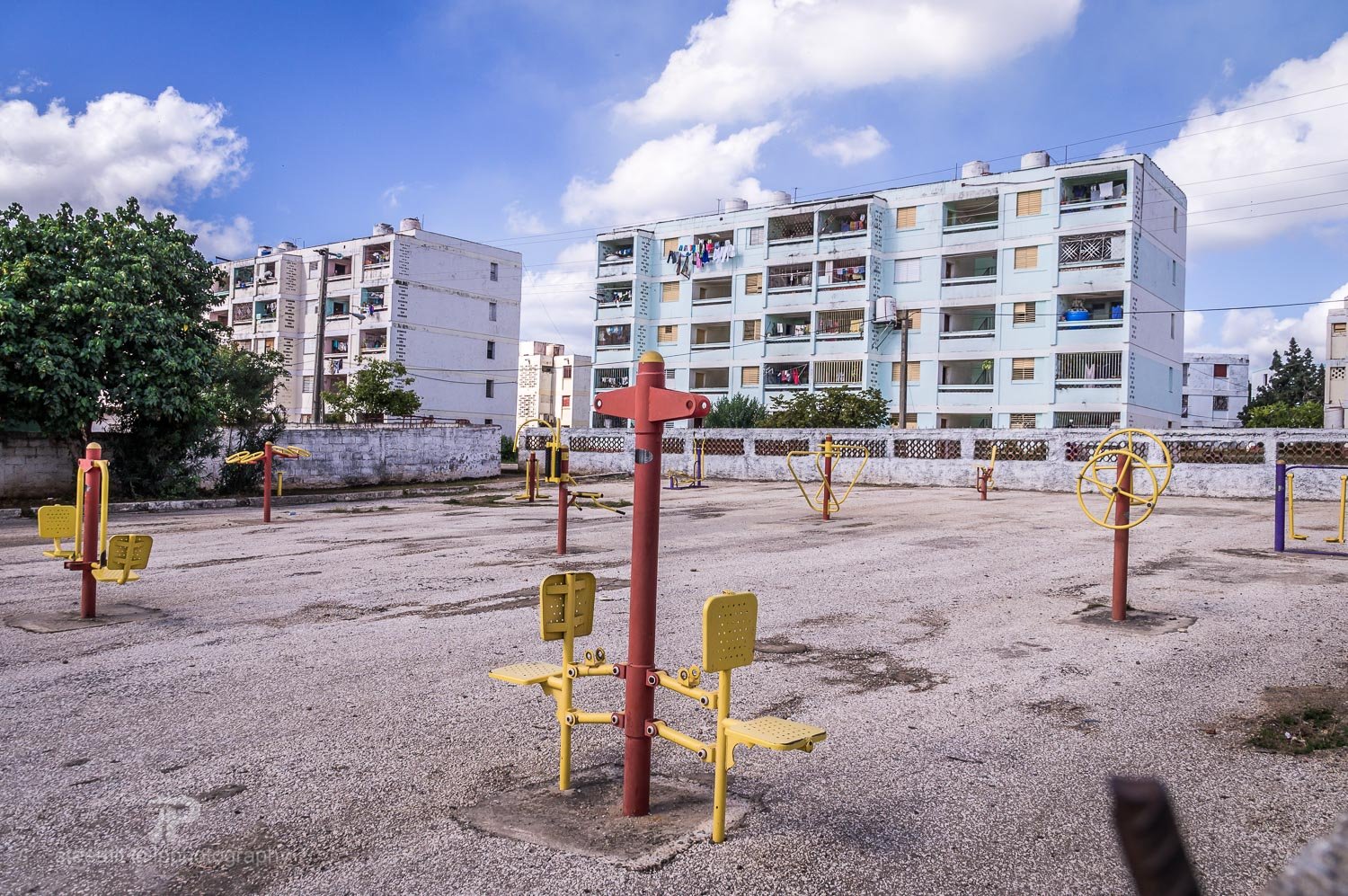
18mm, f8, 1/500; Click on image to enlarge.
The Suburbs of Trinidad
The suburbs of Trinidad look way different from the renovated Colonial buildings in the centre. This is the Cuban reality that most tourists never get to see.
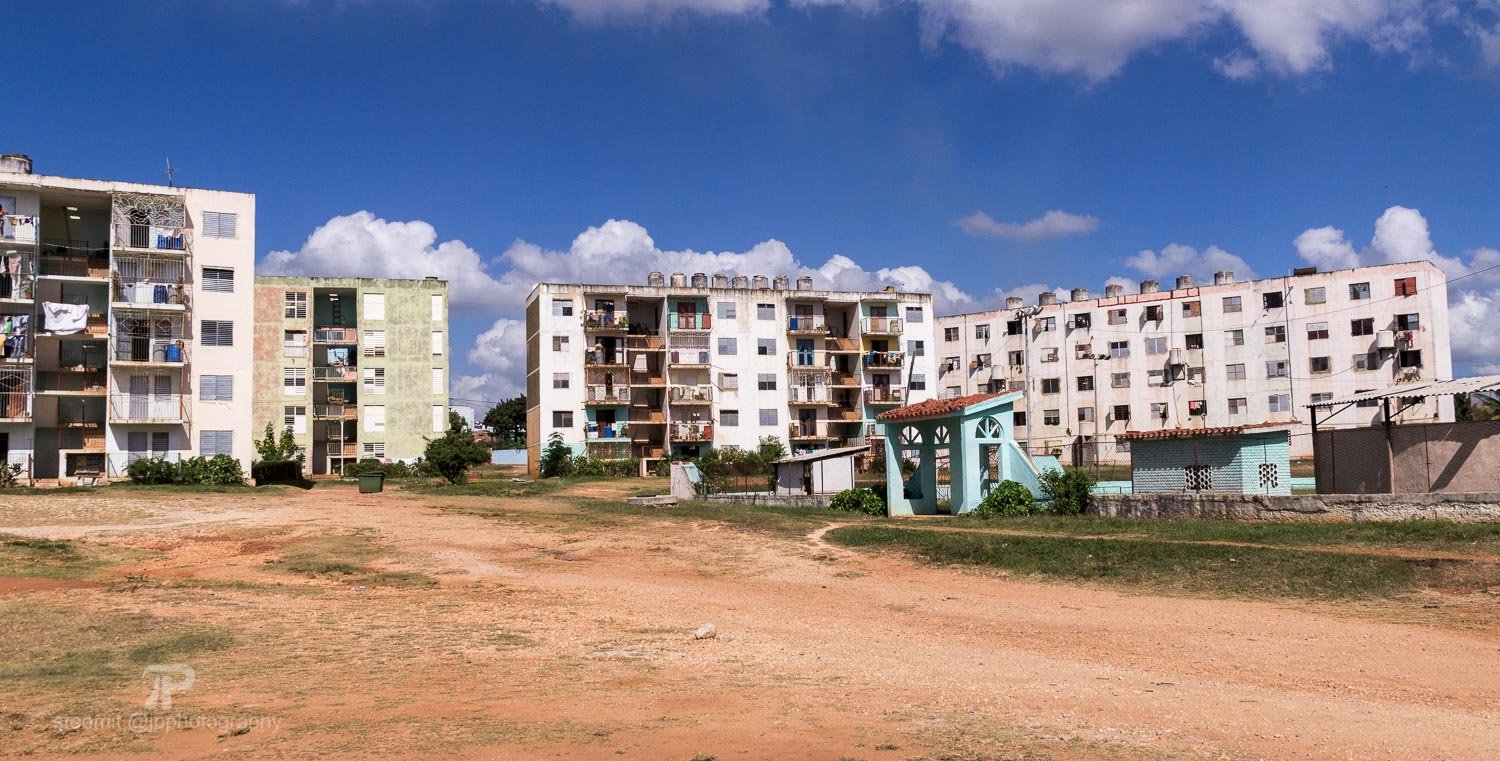
18mm, f9, 1/1600; Click on image to enlarge.
Lining up for Internet
Many people in Cuba have never used the internet, although there are several telepuntos available across Cuba. The telepuntos are basically internet cafés, but internet access is to expensive for most Cubans.
The Western point of view is, that the Cuban government does not want its people to be able to inform themselves about the world outside of the isolated country, but this is just one side of the coin. In fact, for many years the US has successfully blocked all attempts to connect Cuba to the world wide web using a submarine cable. Large parts of the internet connections leaving Cuba are lead over satellite, which incurs high costs. According to Wikipedia, the total download bandwidth between Cuba and the global internet is just 397 Mbit/s! For this reason the Cuban government is hosting a Cuban intranet providing various government run websites and even their own version of Wikipedia (well, you see that censorship might also be a motivation here...).
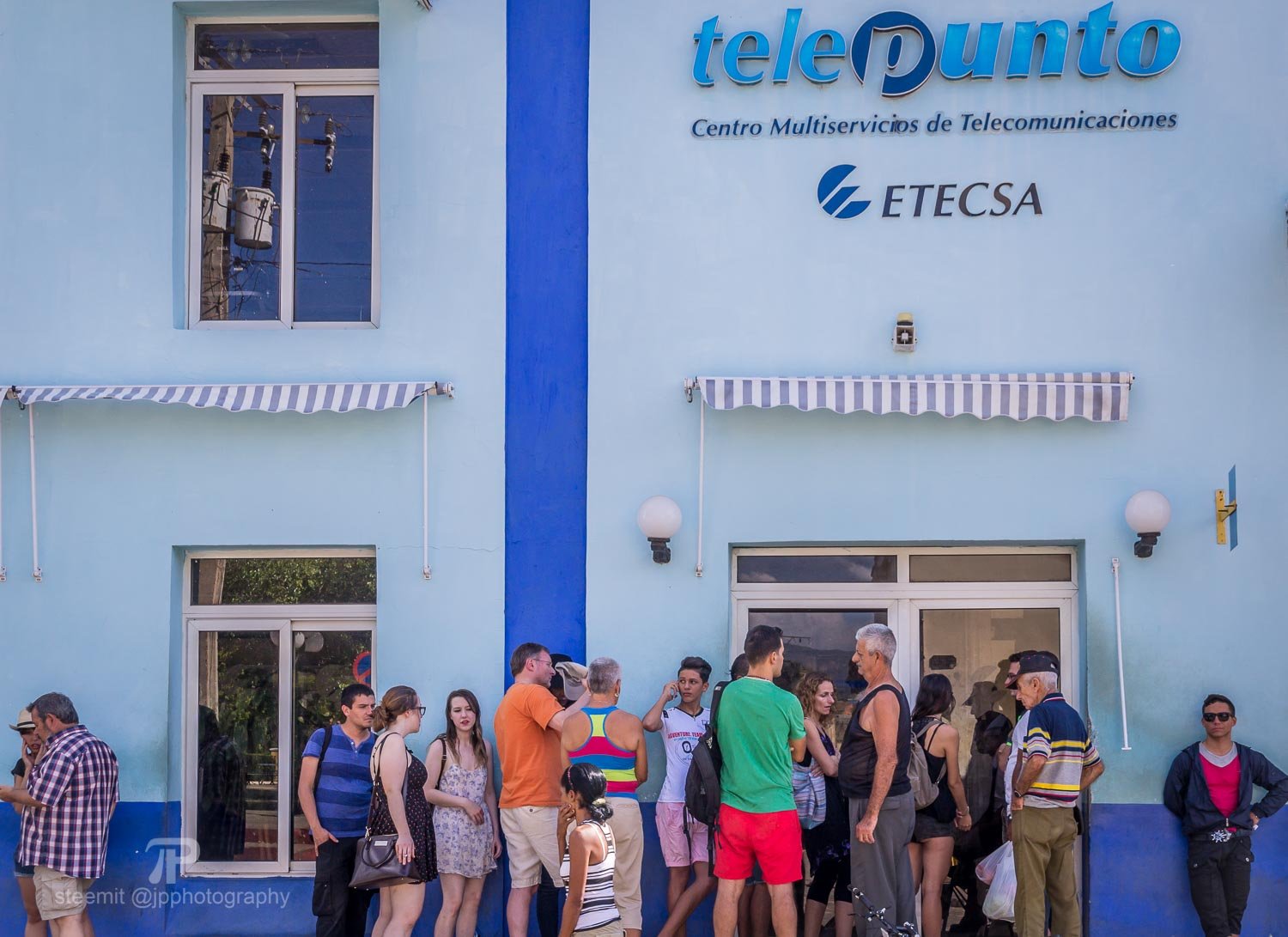
28mm, f8, 1/250; Click on image to enlarge.
Cuba's Wifi Parks
While in private homes internet access is still not available legally, the Cuban government has installed various Wifi hotspots in parks around the country just a few months before I visited in 2015. Internet is priced at about 2 CUC per hour and therefore too expensive to most Cubans.
Tourists love the Wifi hotspots and it is funny to watch hordes of tourists gathering in local parks. Did you notice the boy in the photo who is the only one without a smartphone in these hands? And then parents complain about their internet-addicted kids...
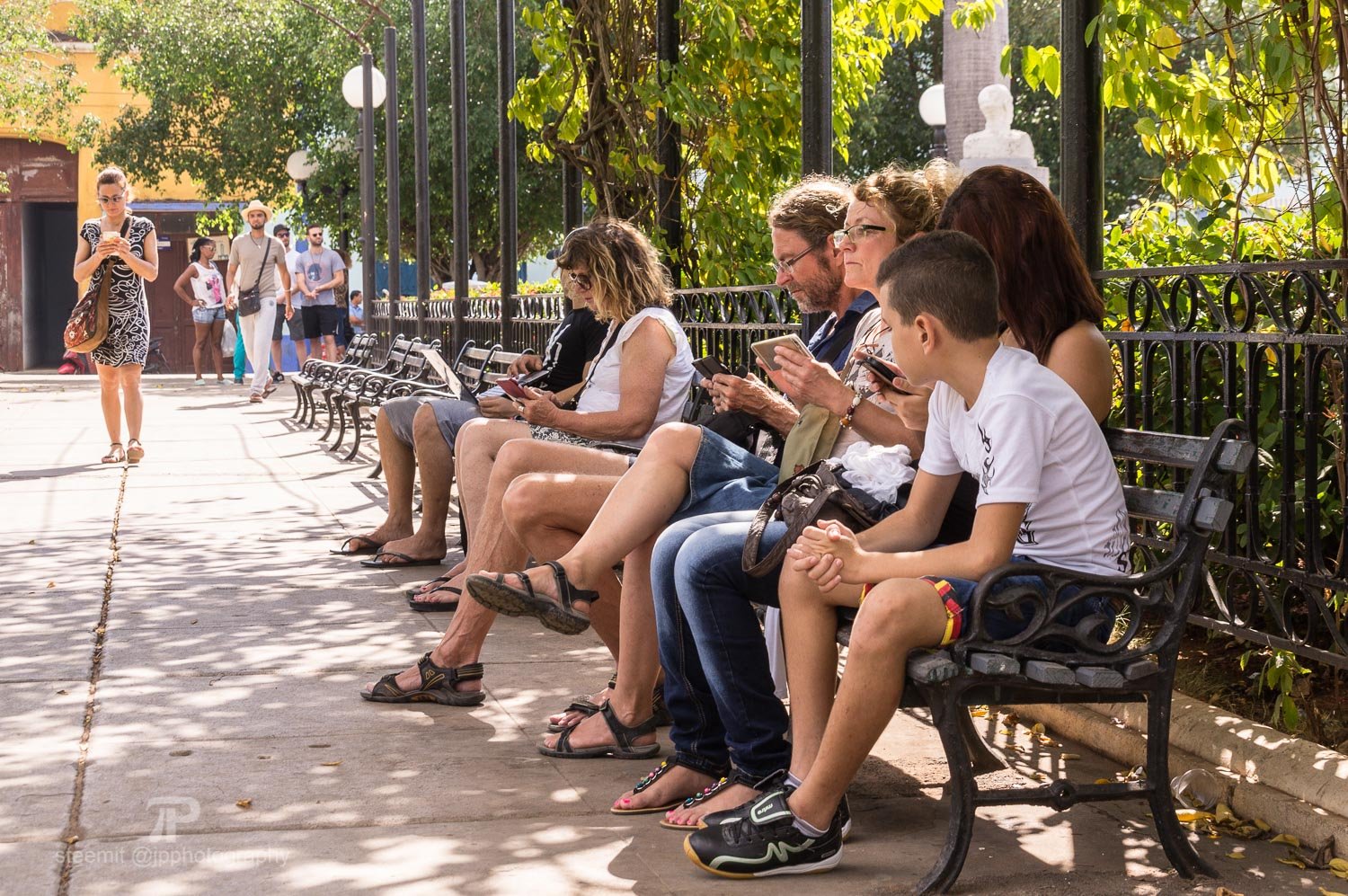
35mm, f6.3, 1/160; Click on image to enlarge.
Change is coming
With the increasing adoption of internet and the introduction of private businesses Cuba is changing quickly. When I was there, there were still big hopes in the Obama administration to discontinue the embargo, but with the current US-government it seems like this will have to wait.
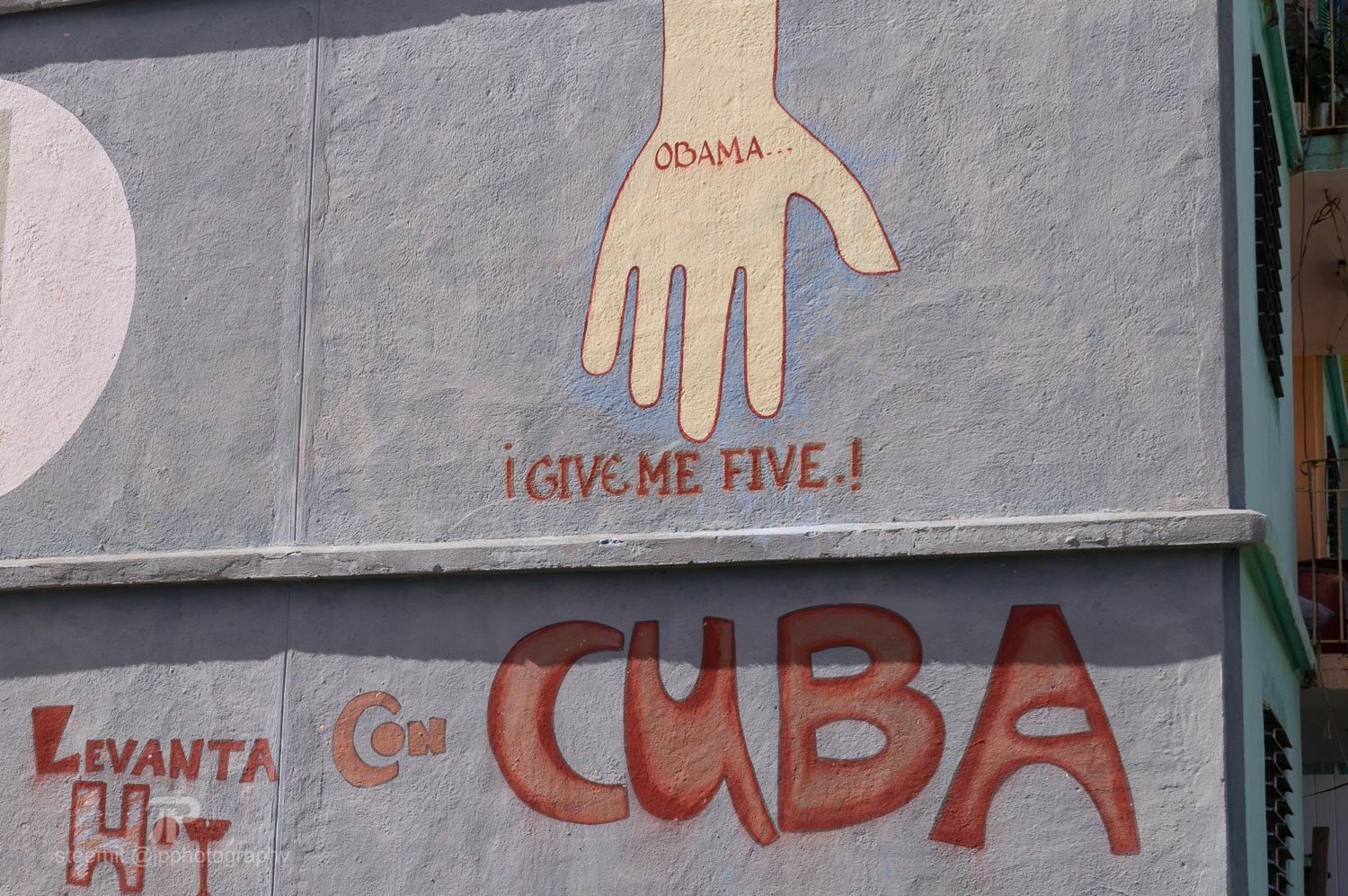
30mm, f8, 1/640; Click on image to enlarge.
I hope you have enjoyed my photo documentary about Trinidad and I hope I have added some paint to your image of Cuba.
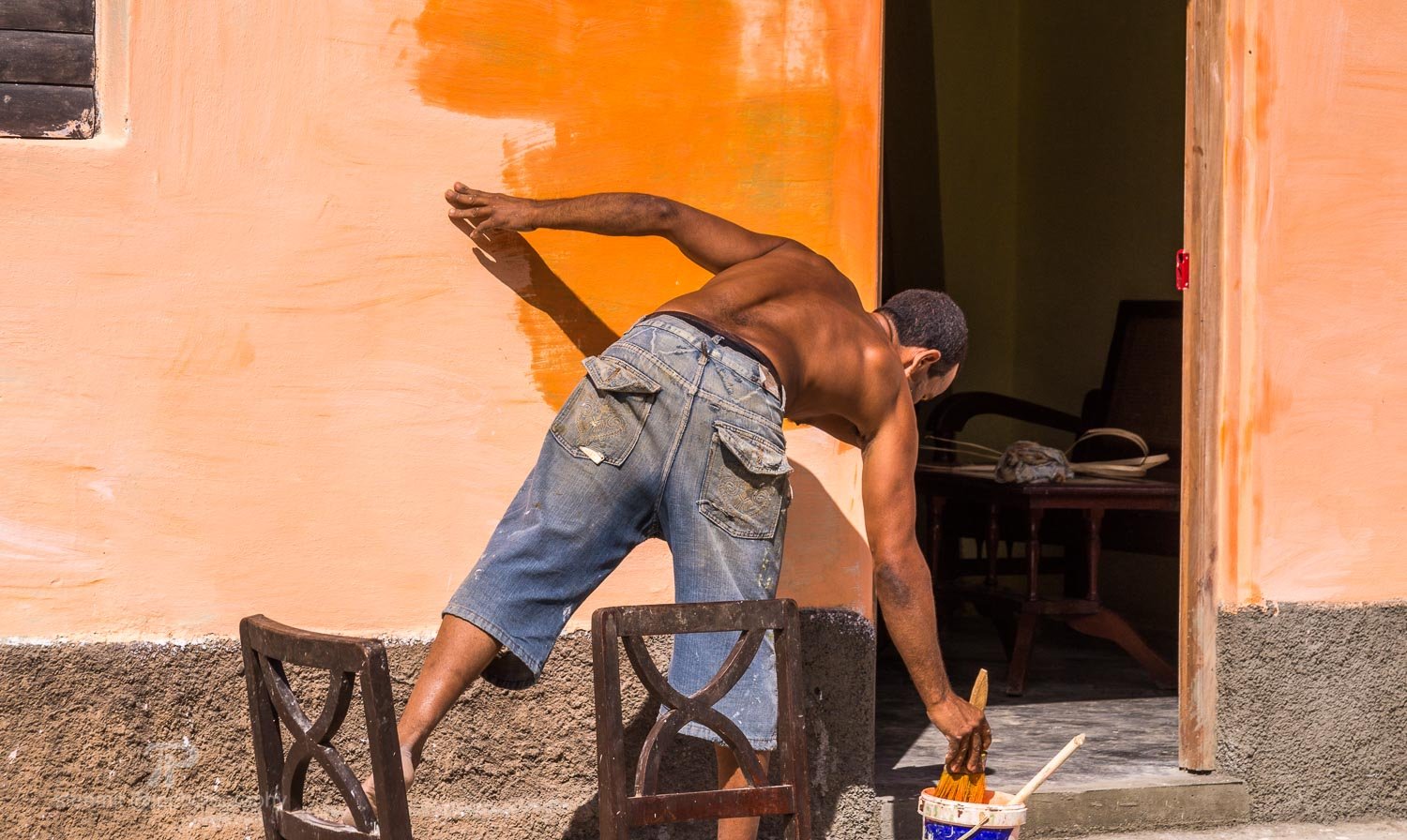
75mm, f9, 1/500; Click on image to enlarge.
Please note that the information in the post is mostly derived from conversations I had during my stay in Cuba and may not be totally accurate.
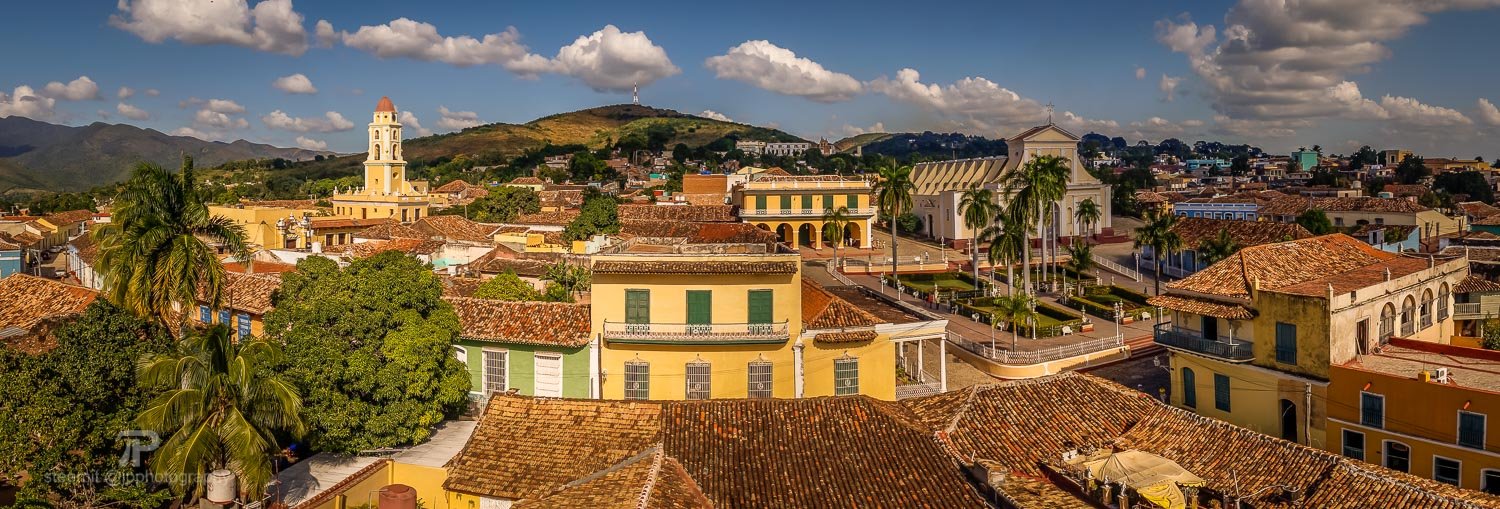
18mm, f8, 1/1000; Click on image to enlarge.
10 days ago I posted my photo documentary about Havana, Cuba to celebrate 50 Followers. Today I hit 100. I want to give back to this amazing community so I decided to do this part two about Trinidad, Cuba.
All the photos in this post are original and many of them have never been published before. All my photos are available for licensing, please contact me through my Website.
